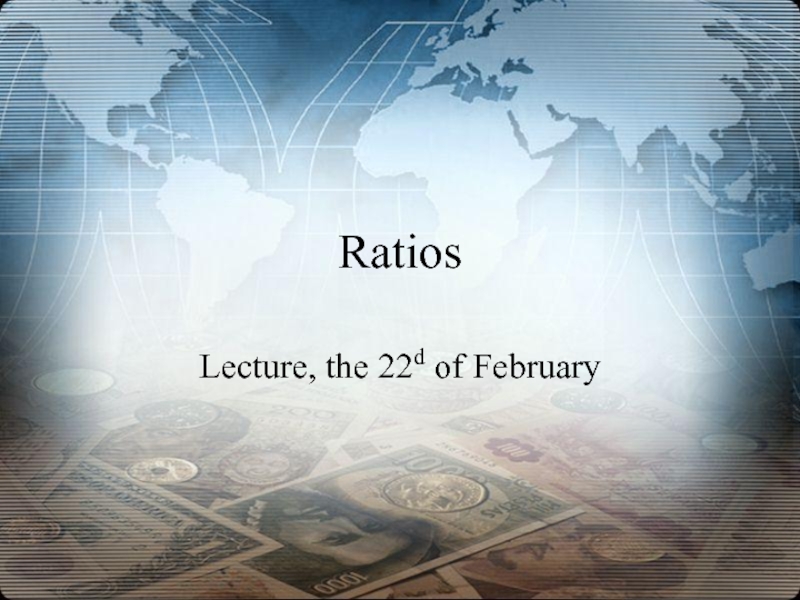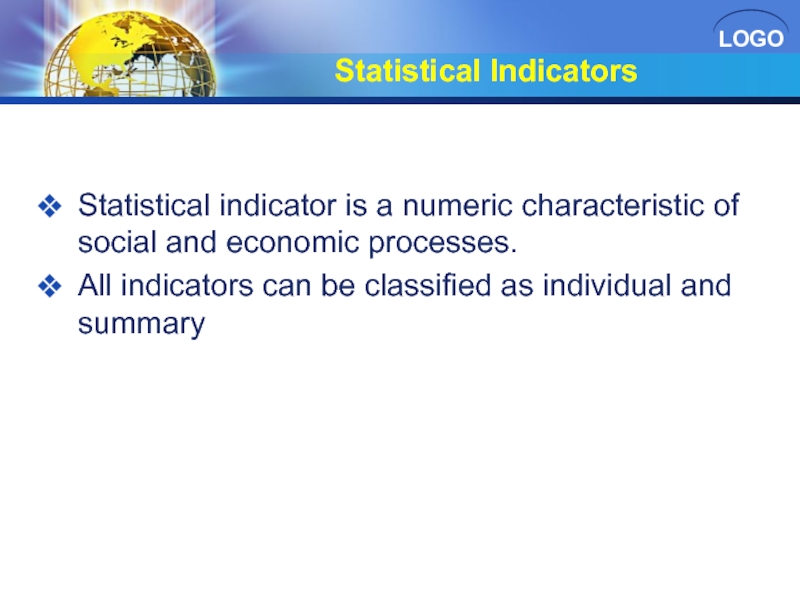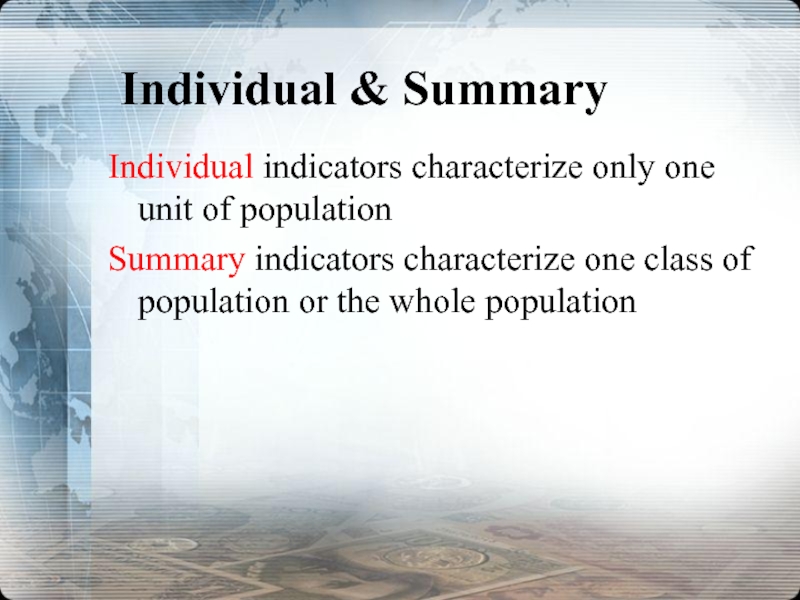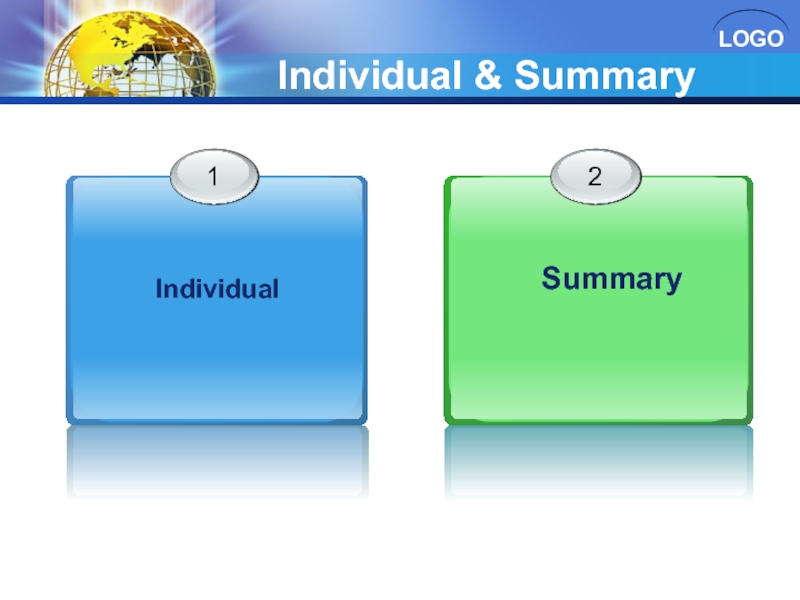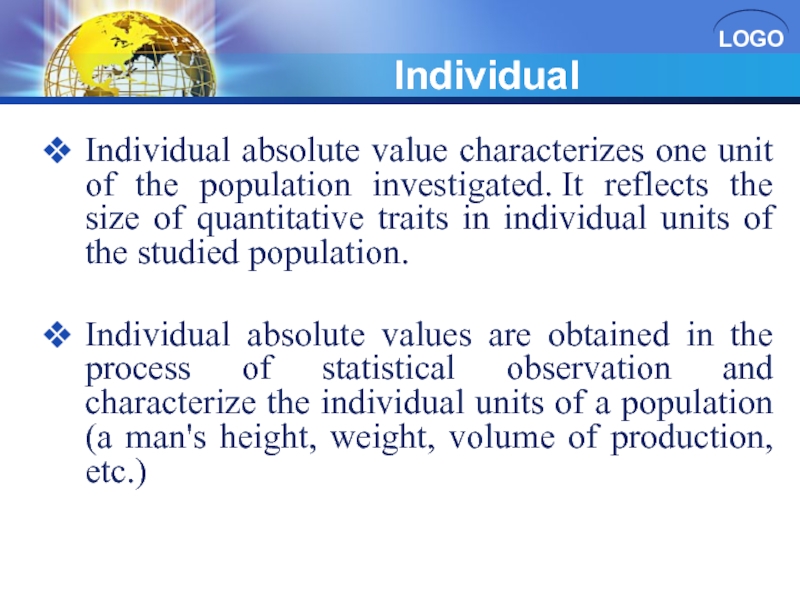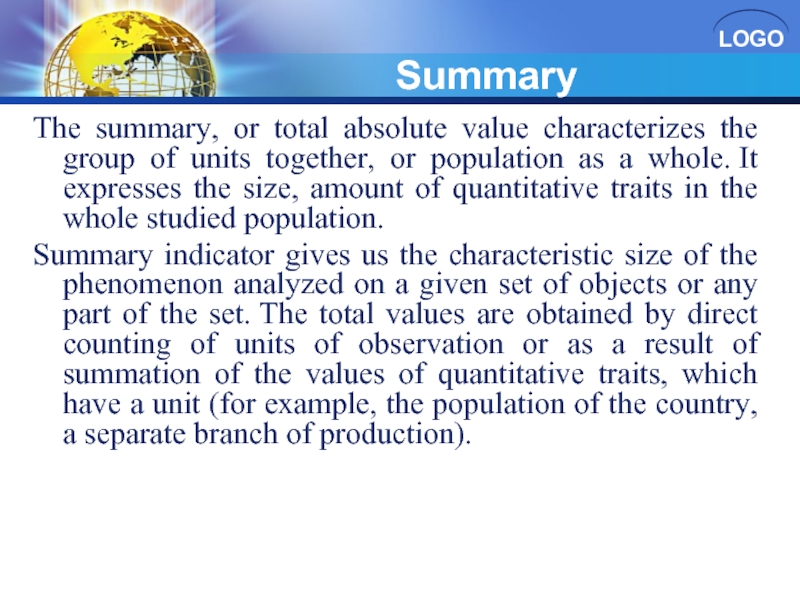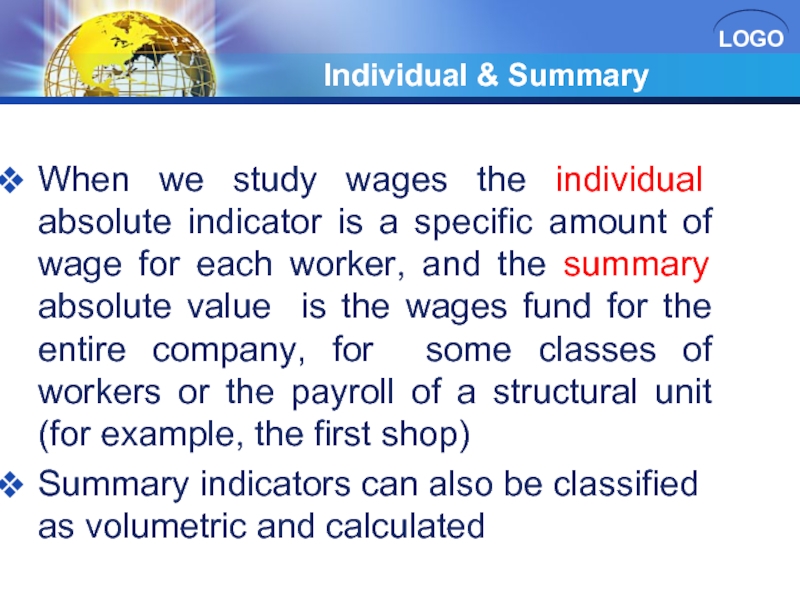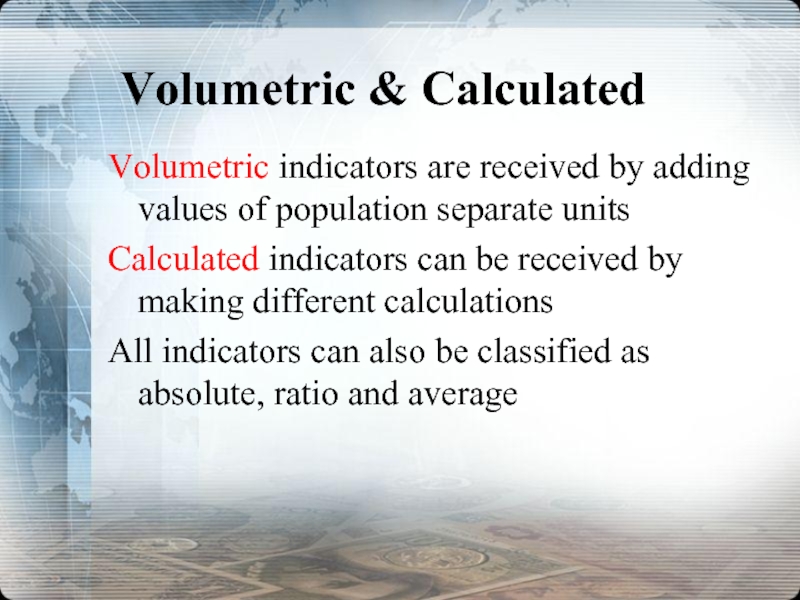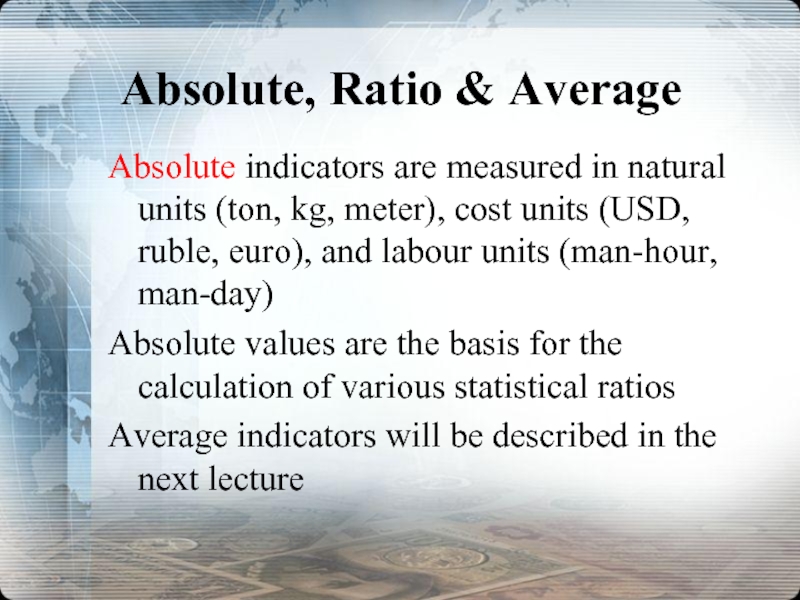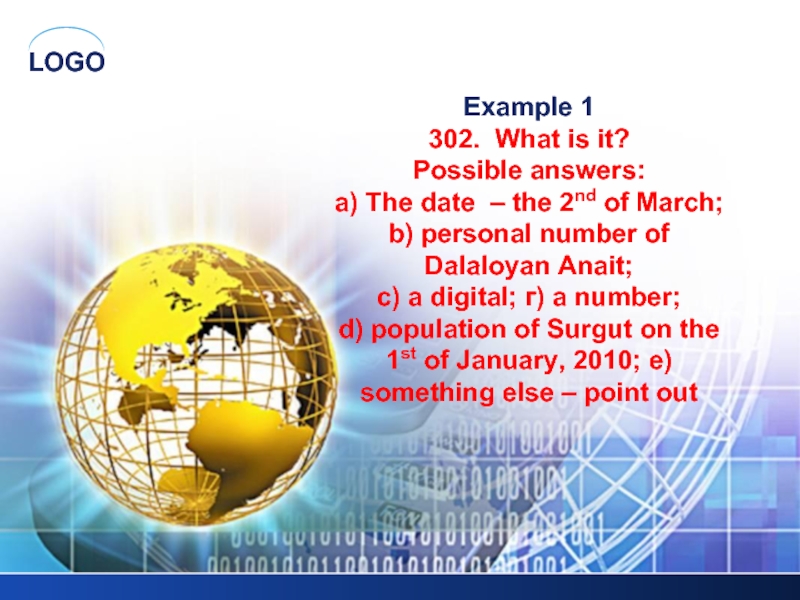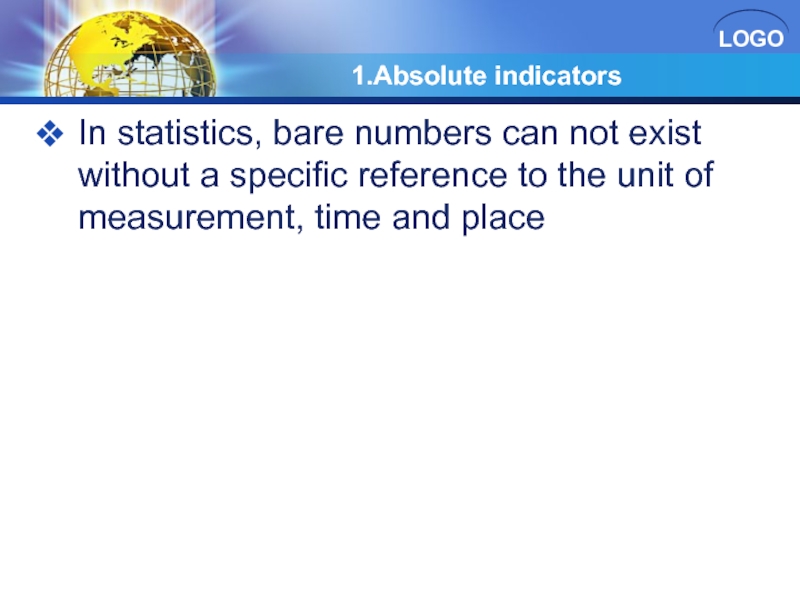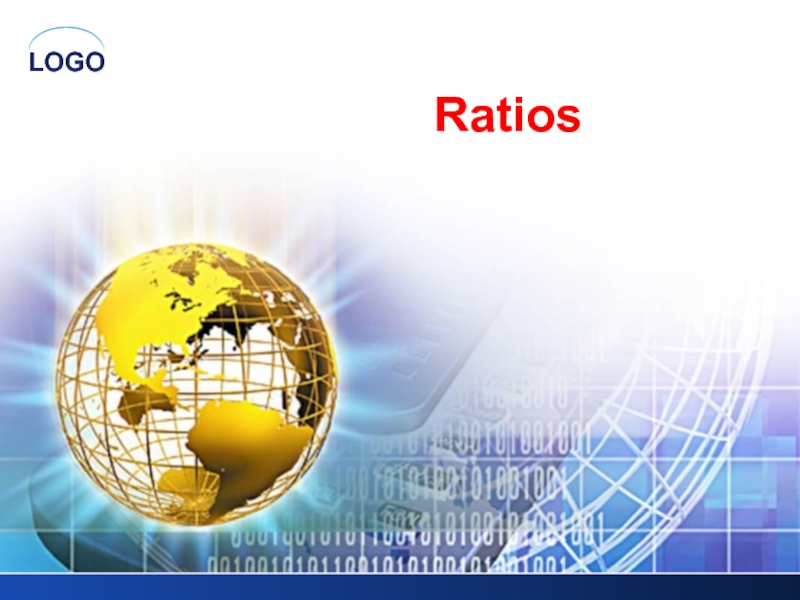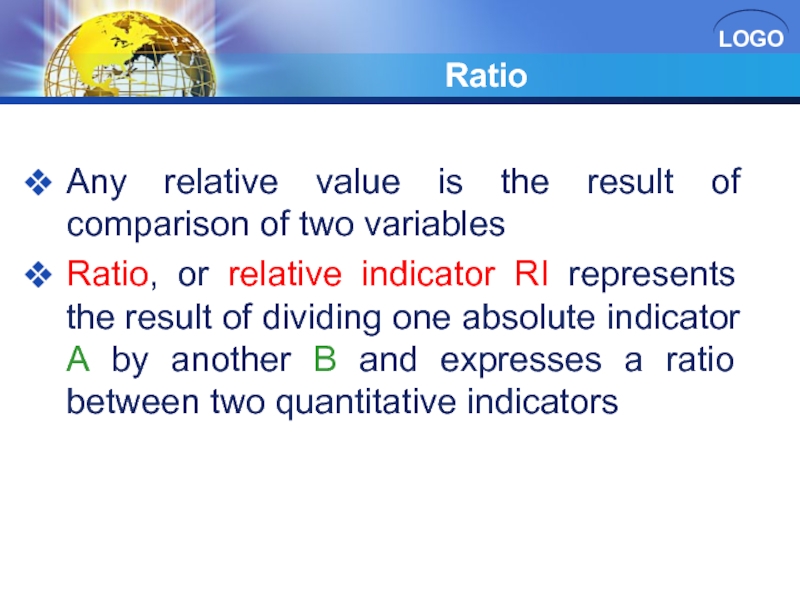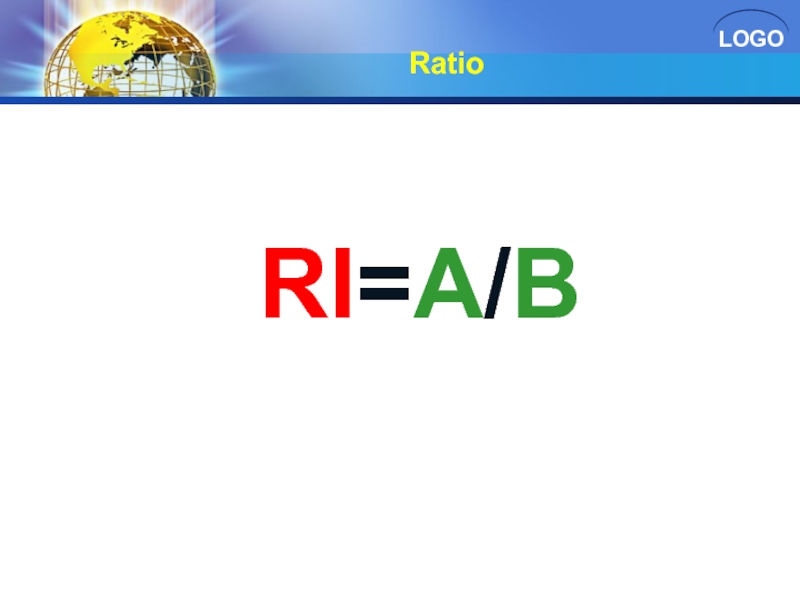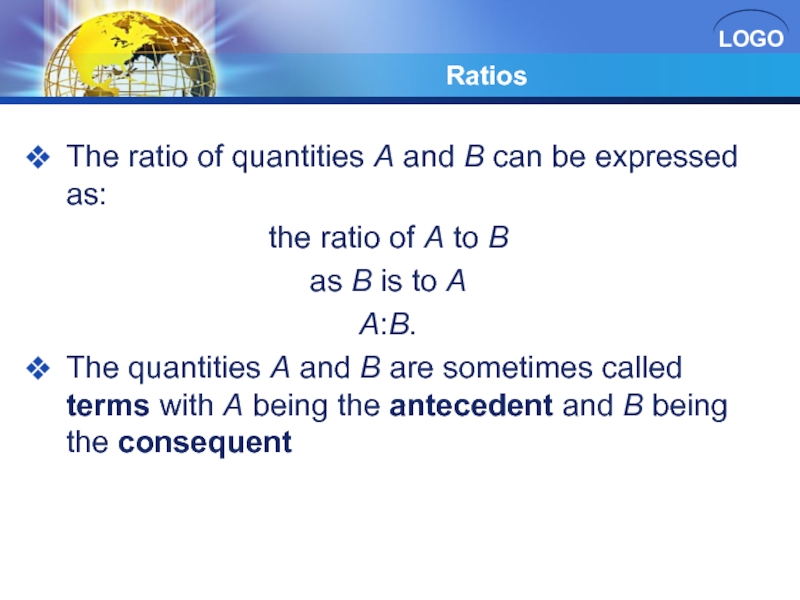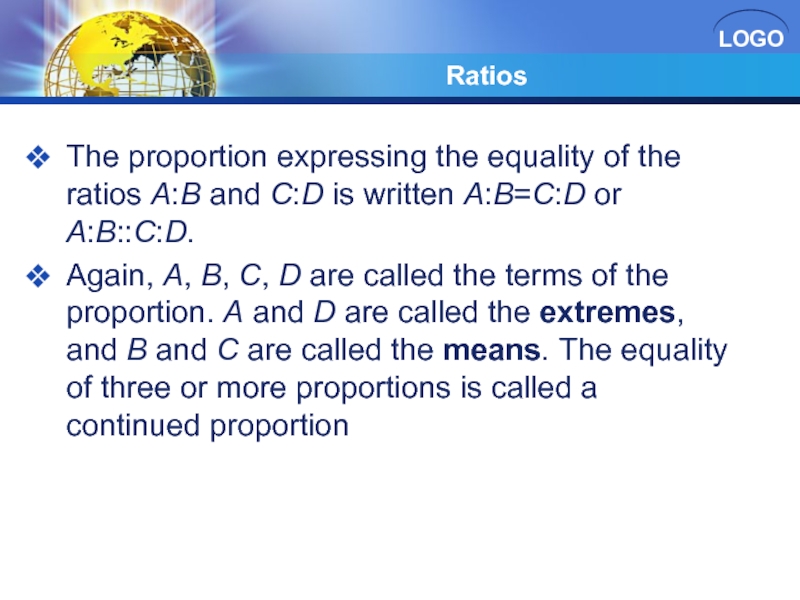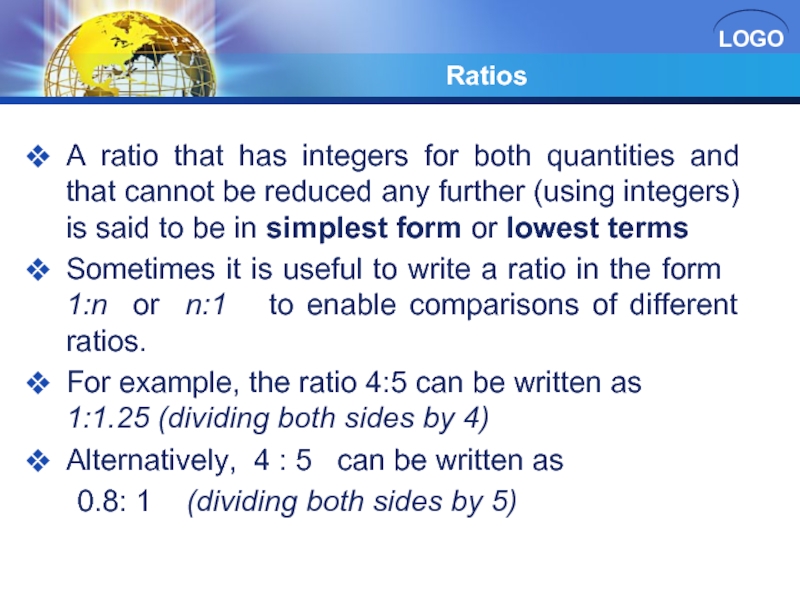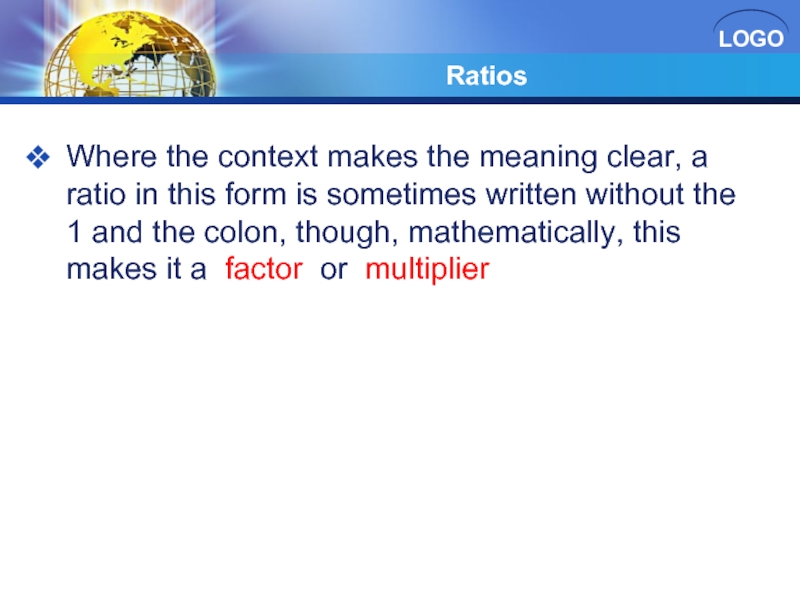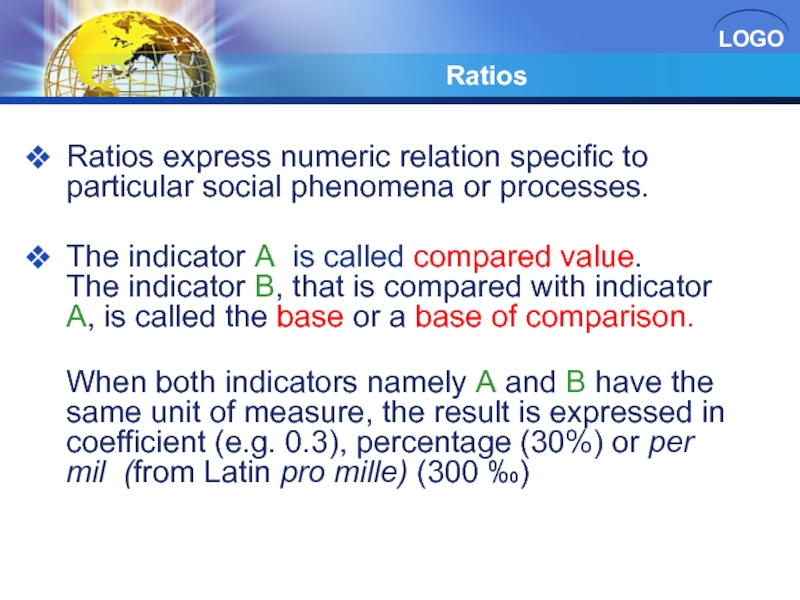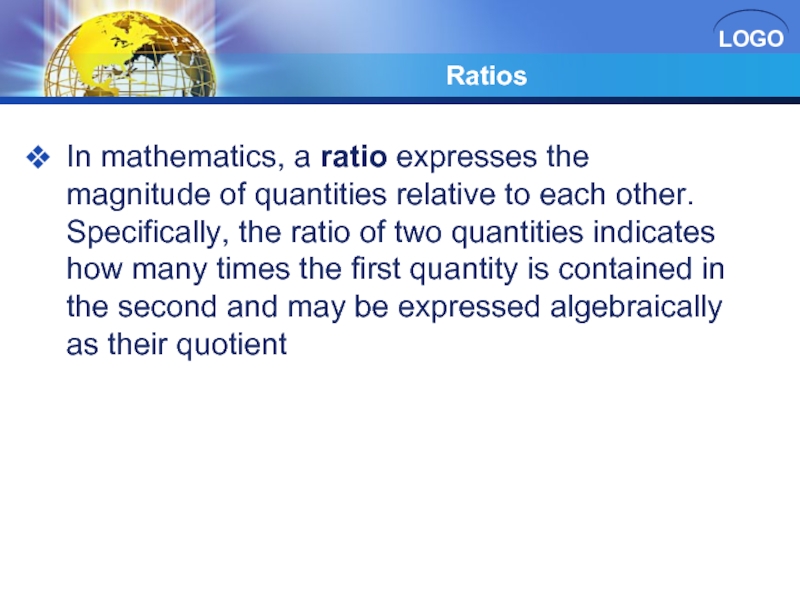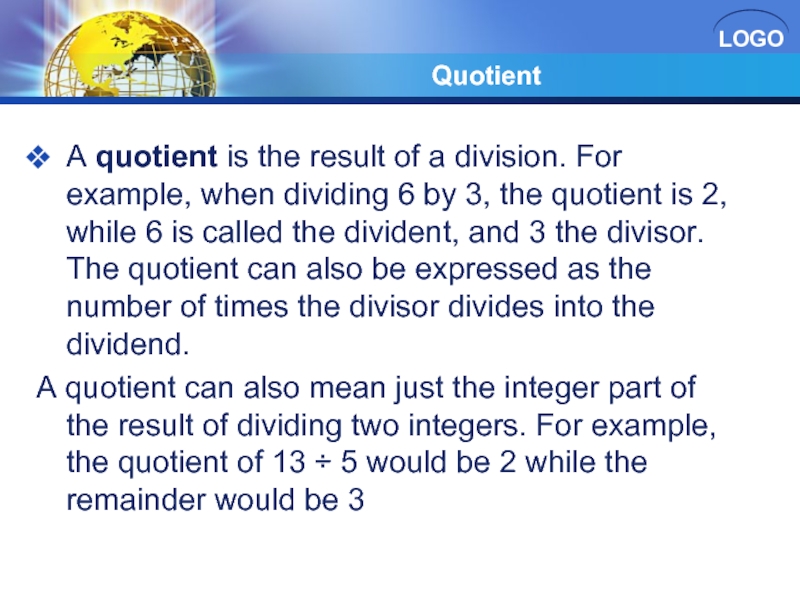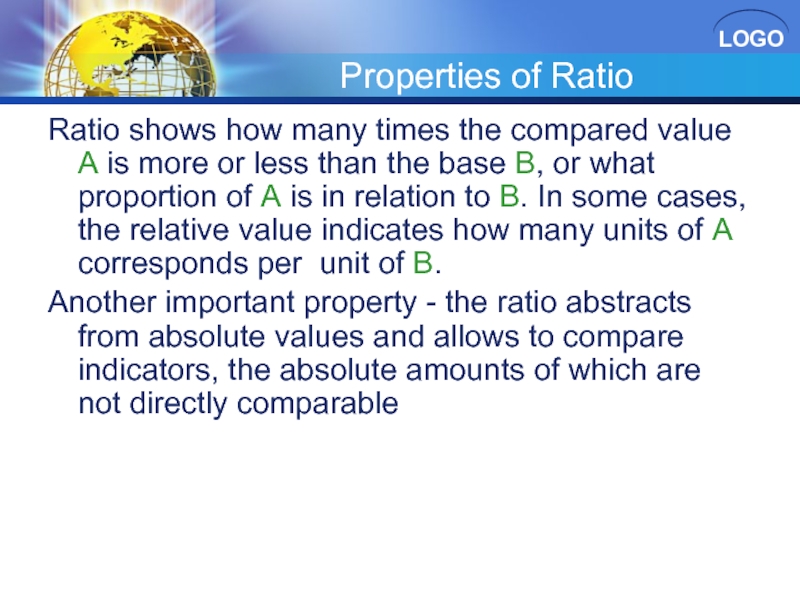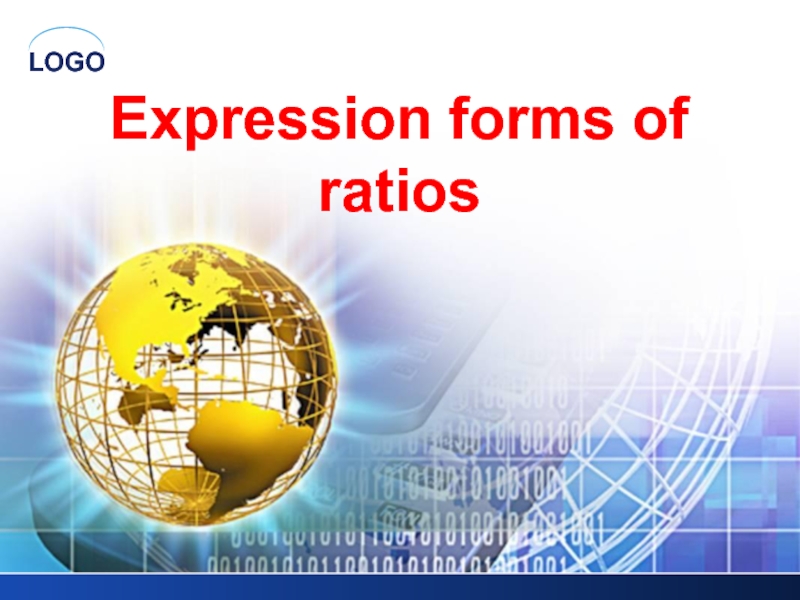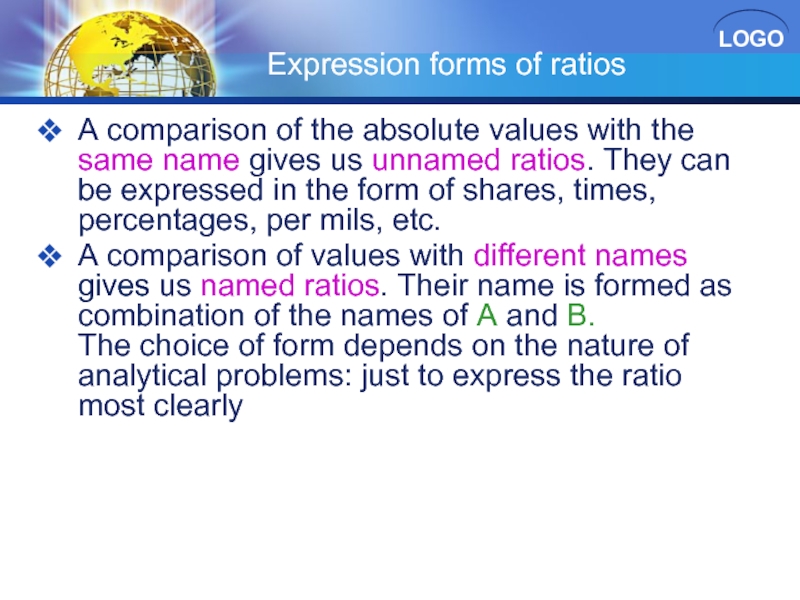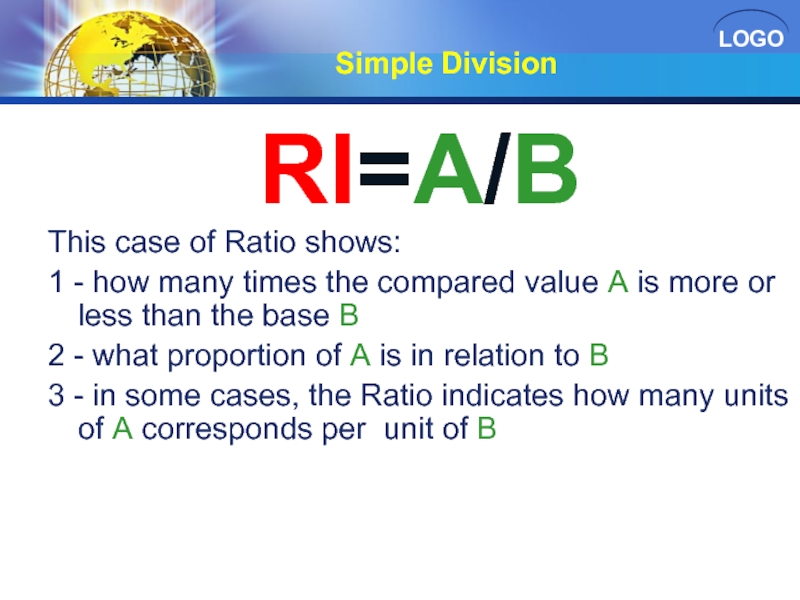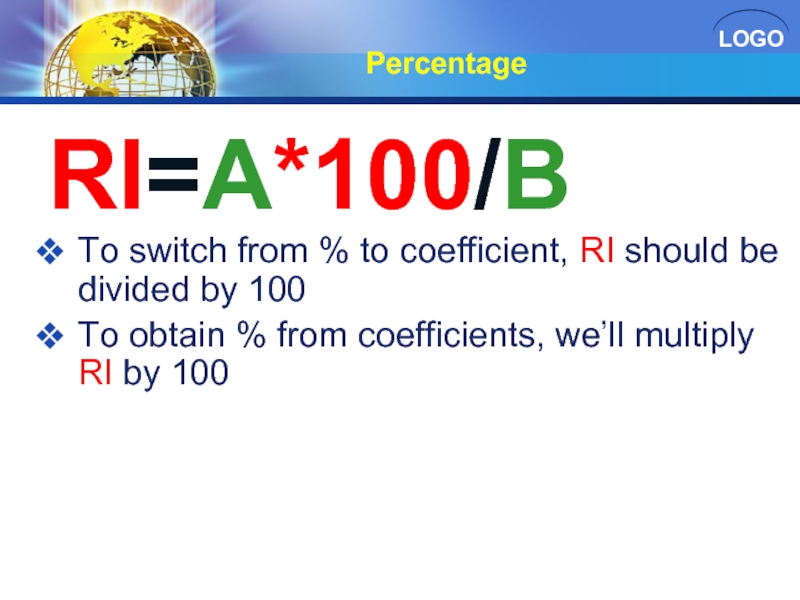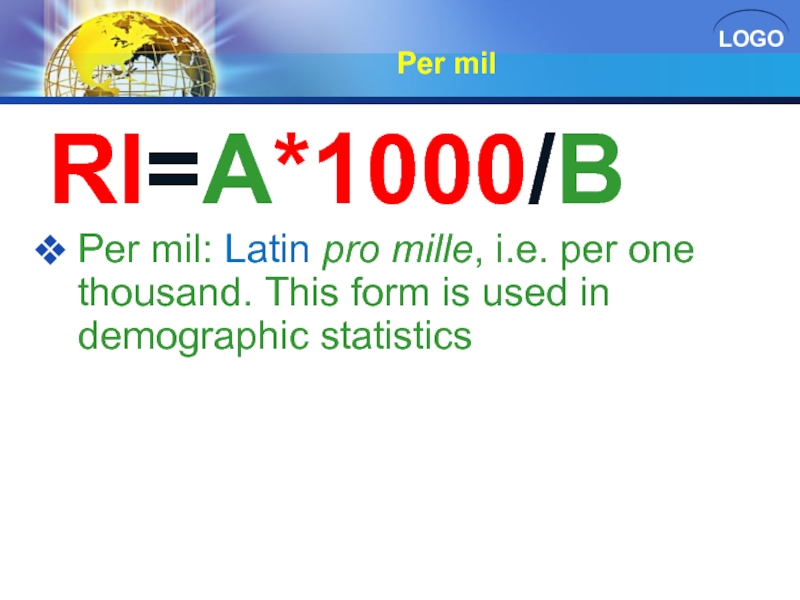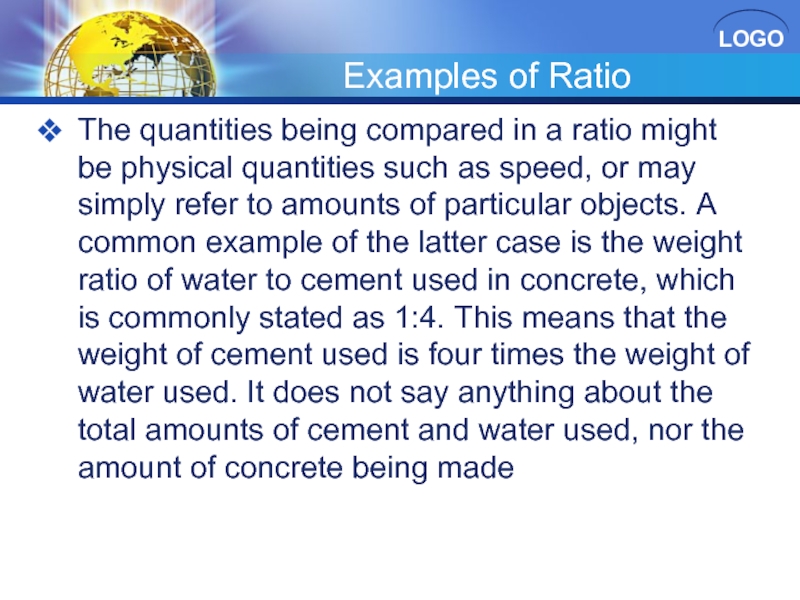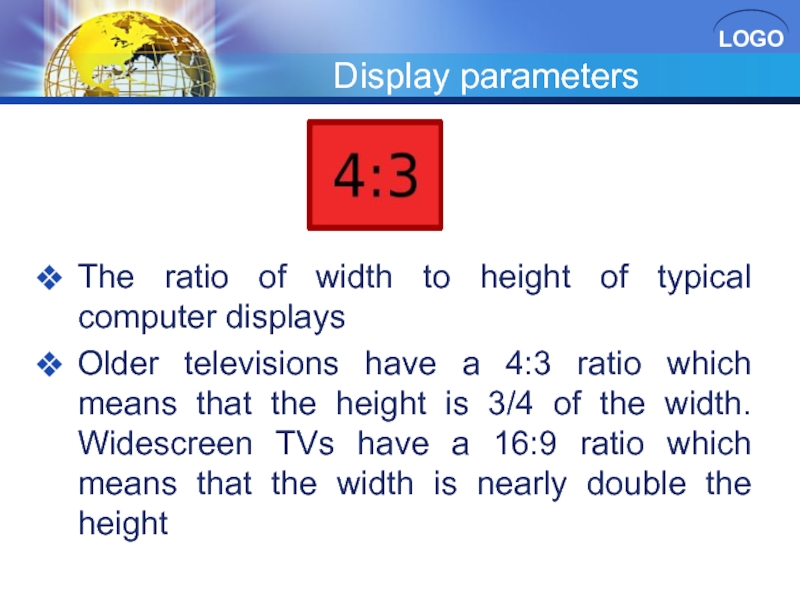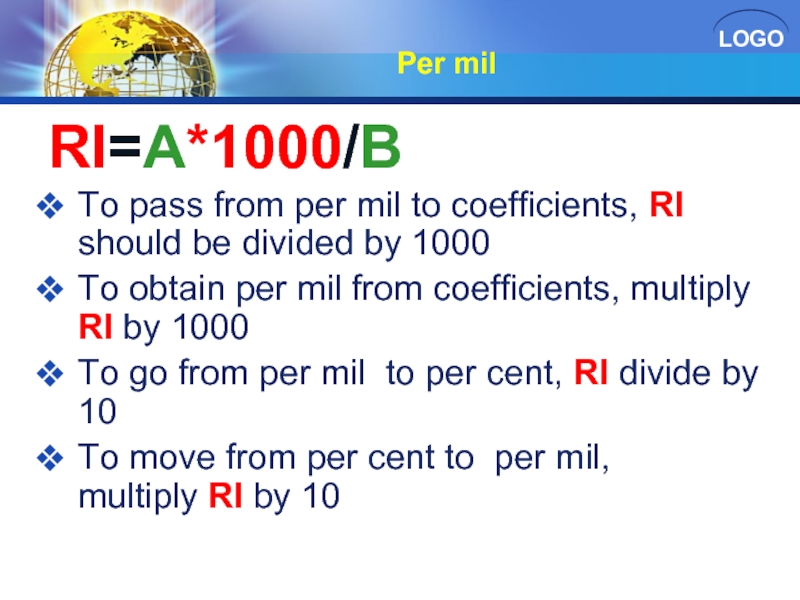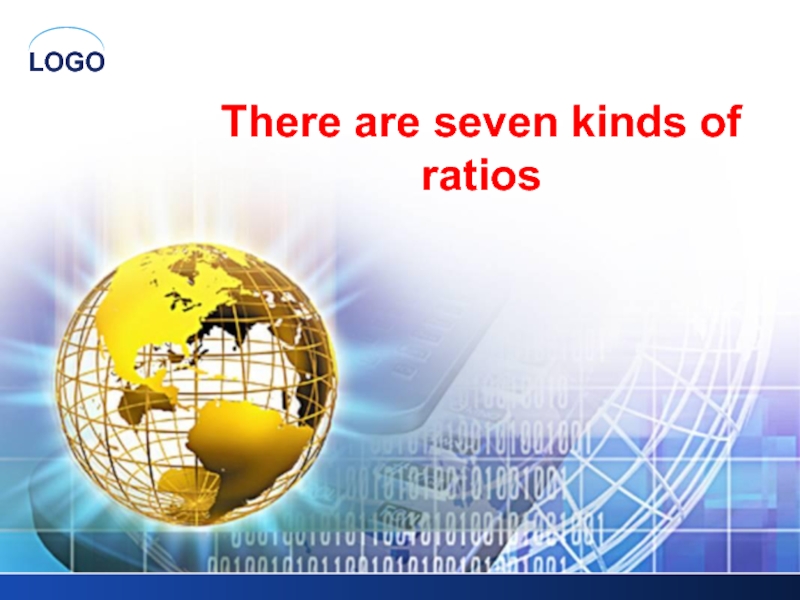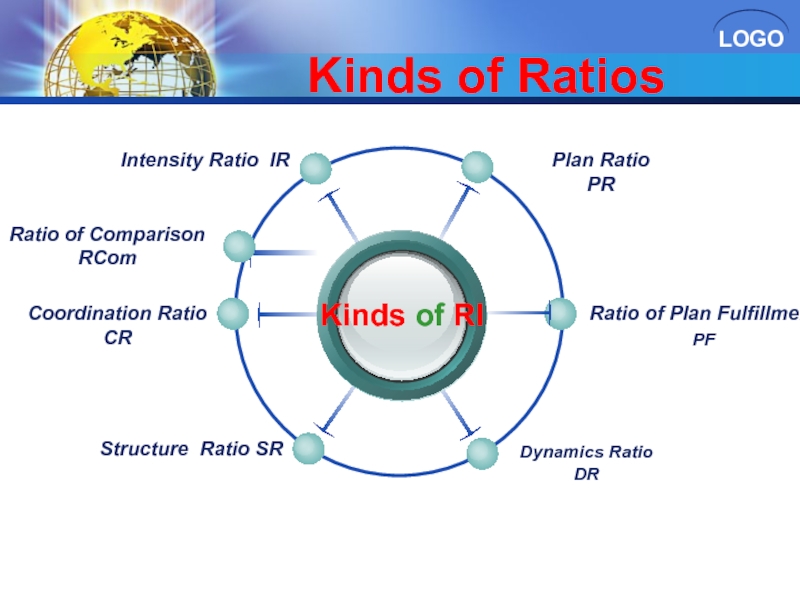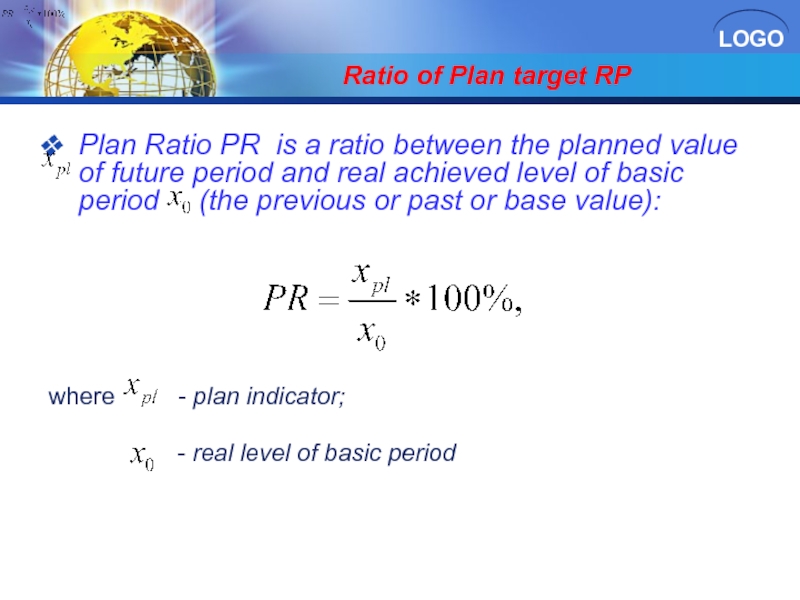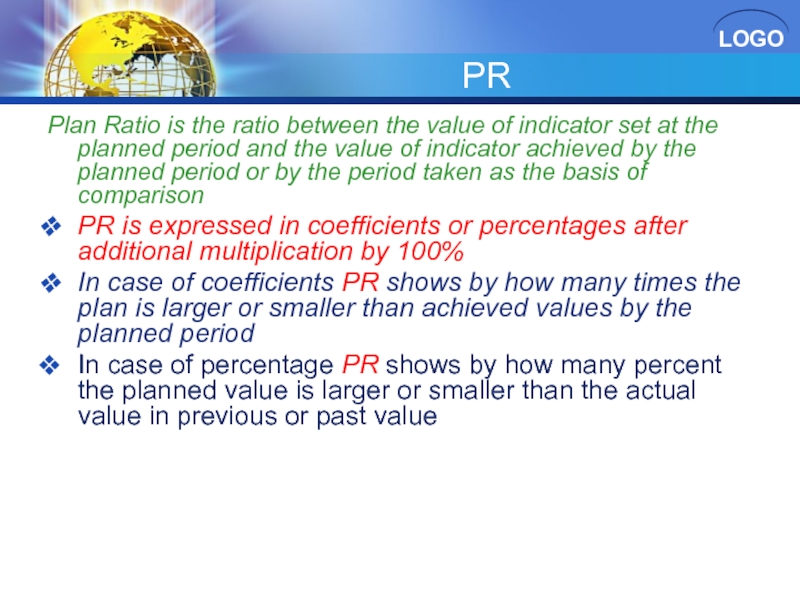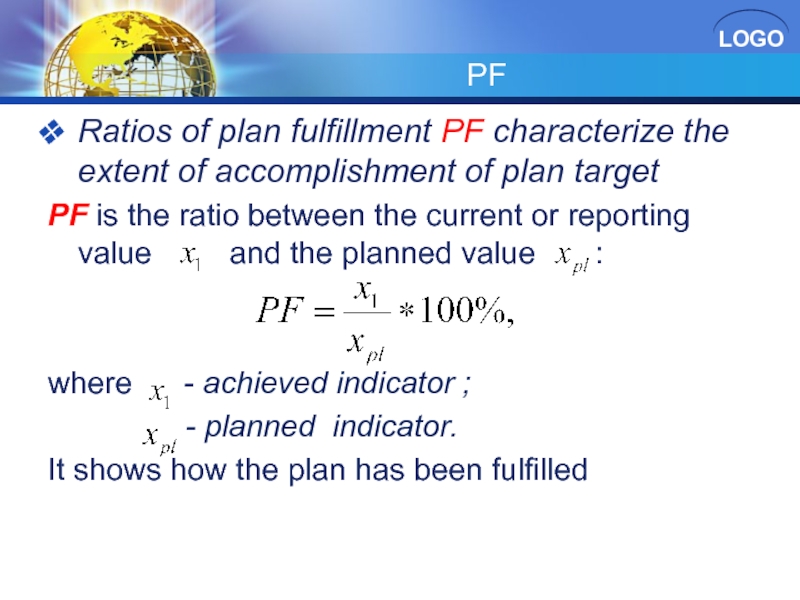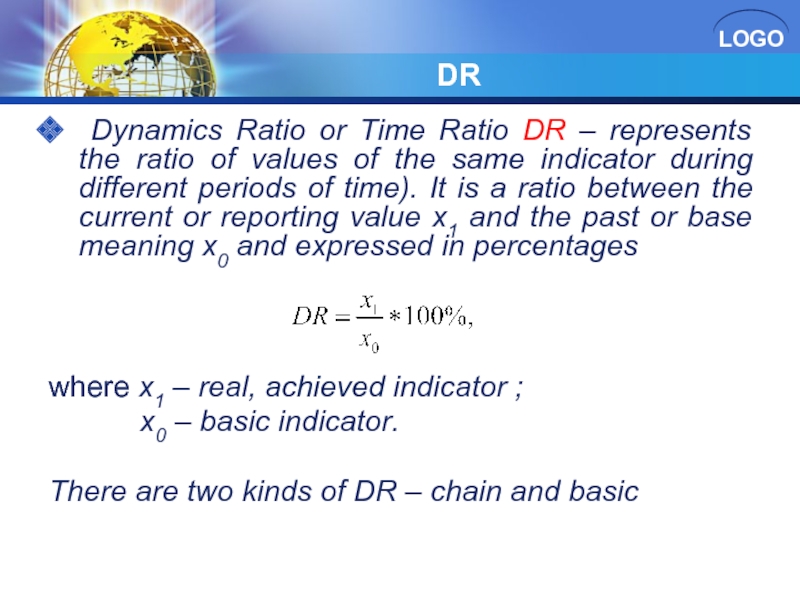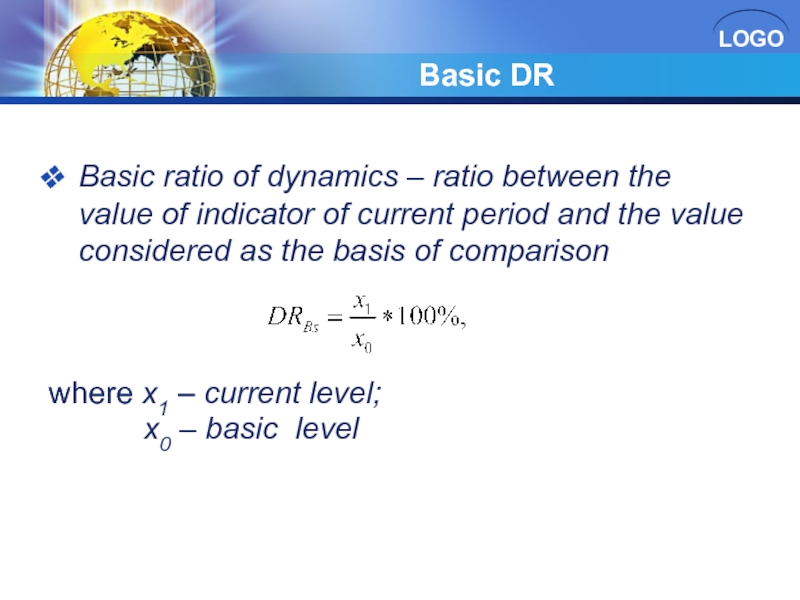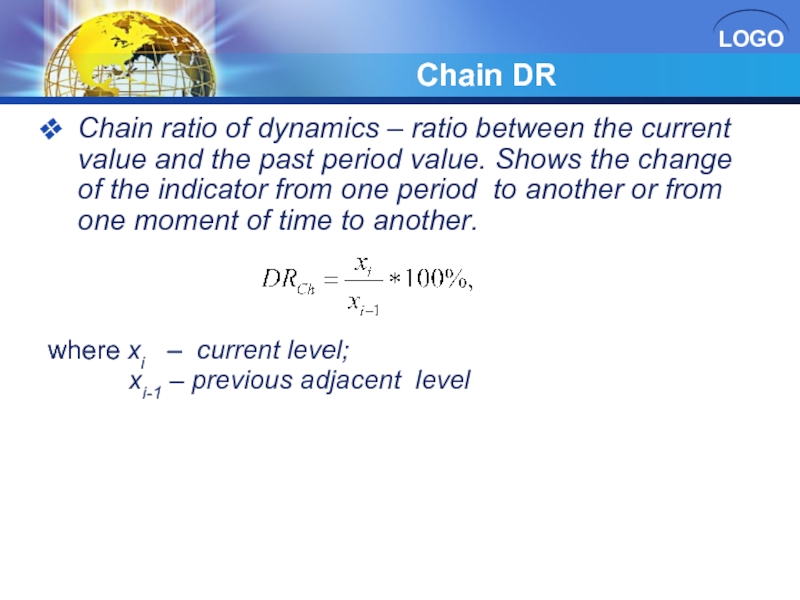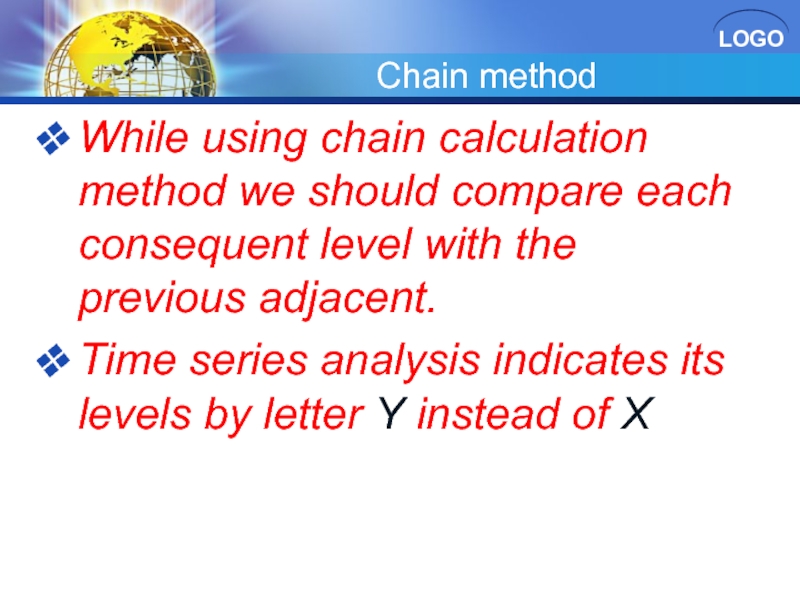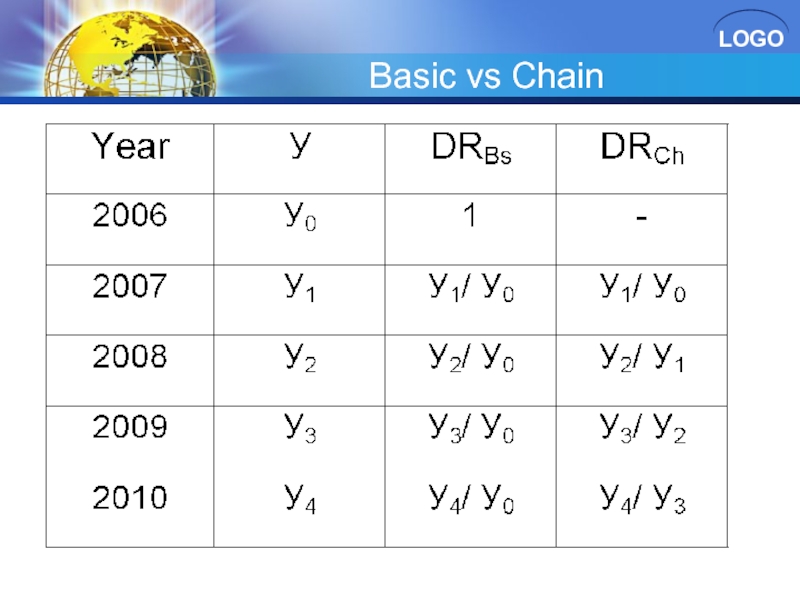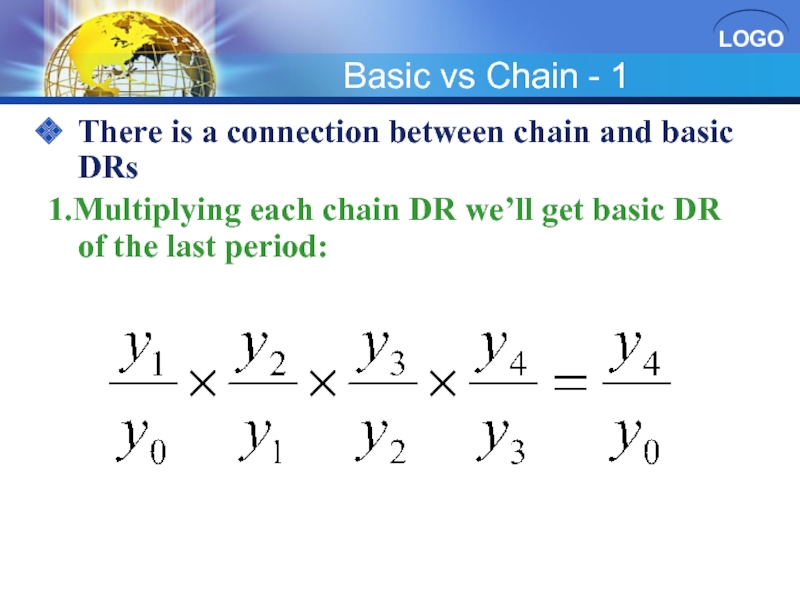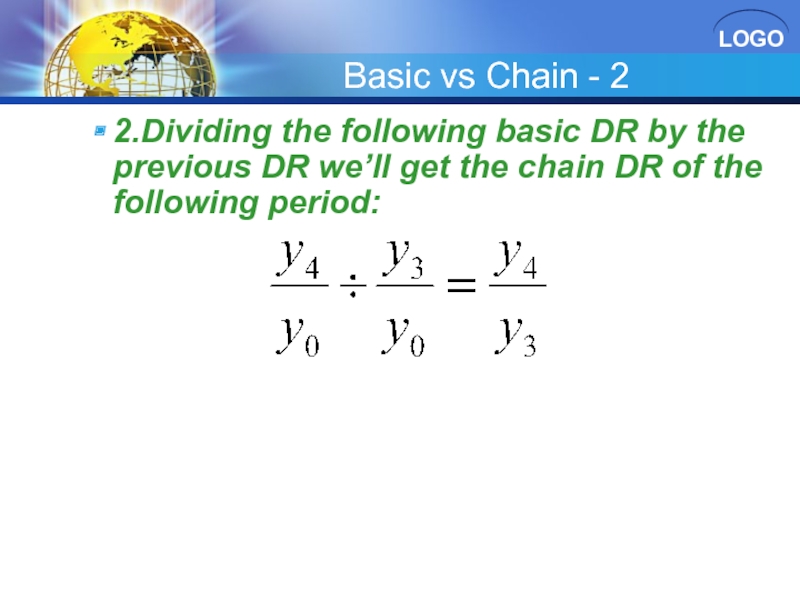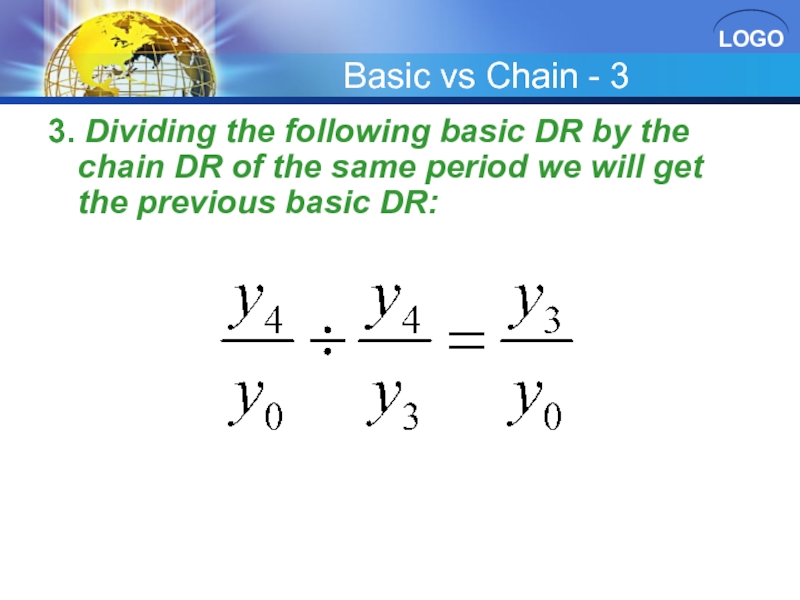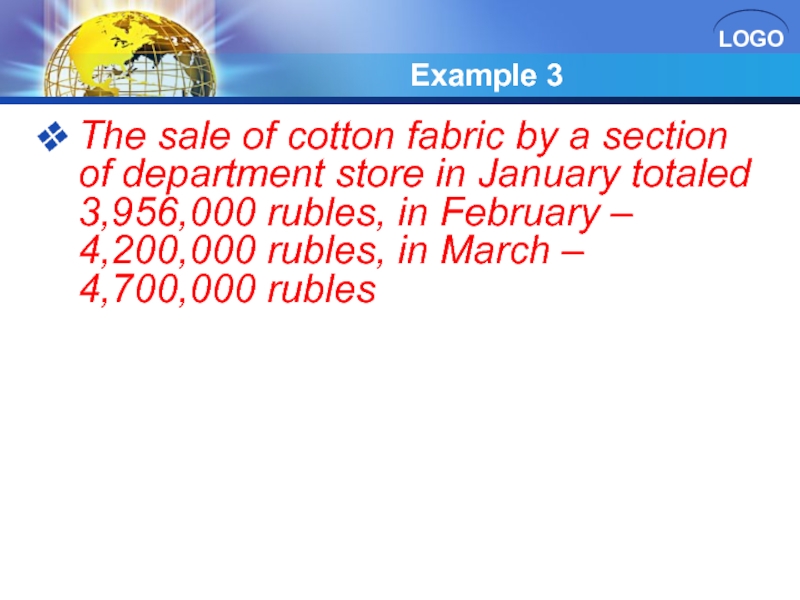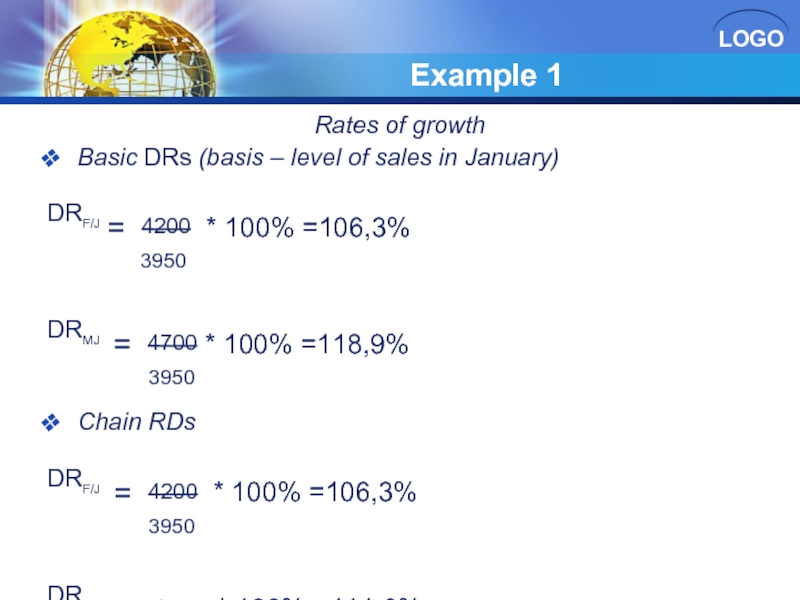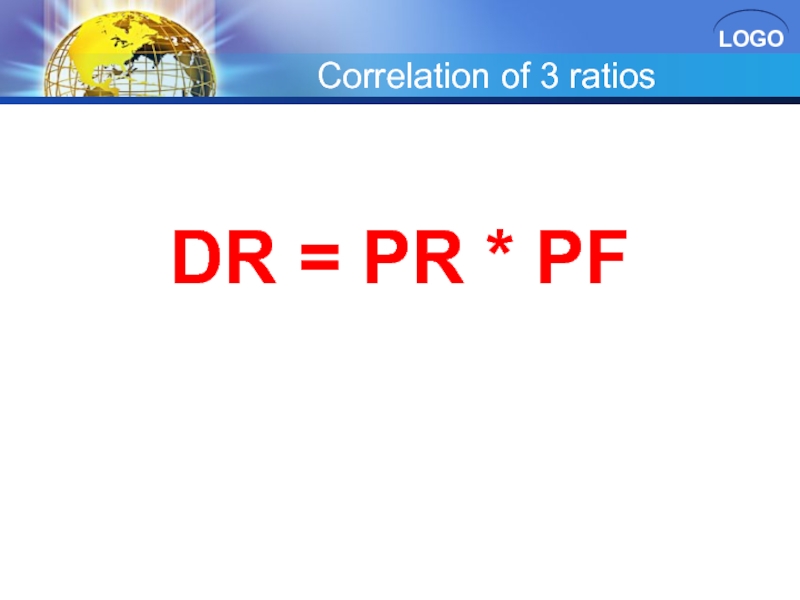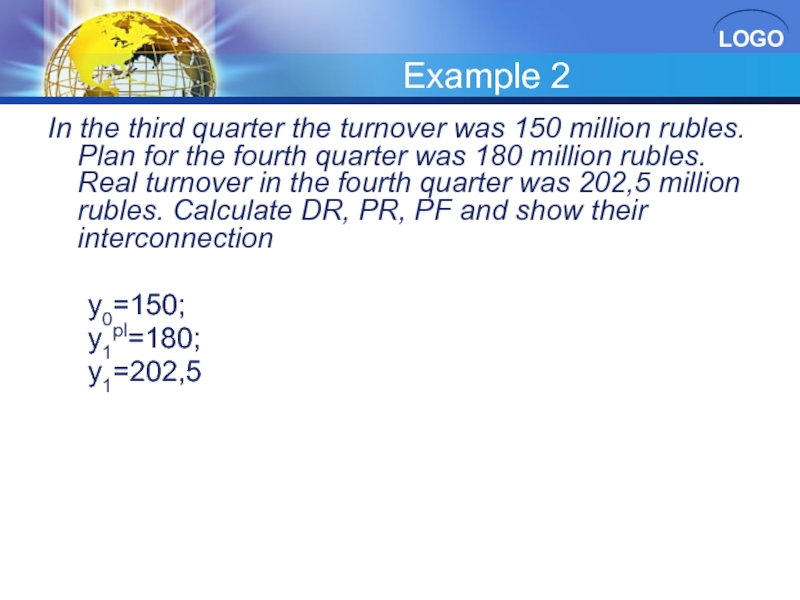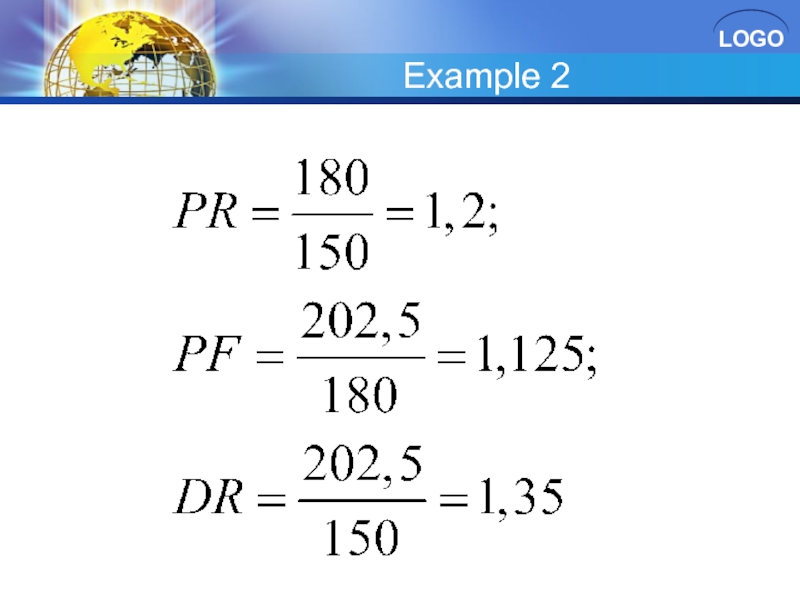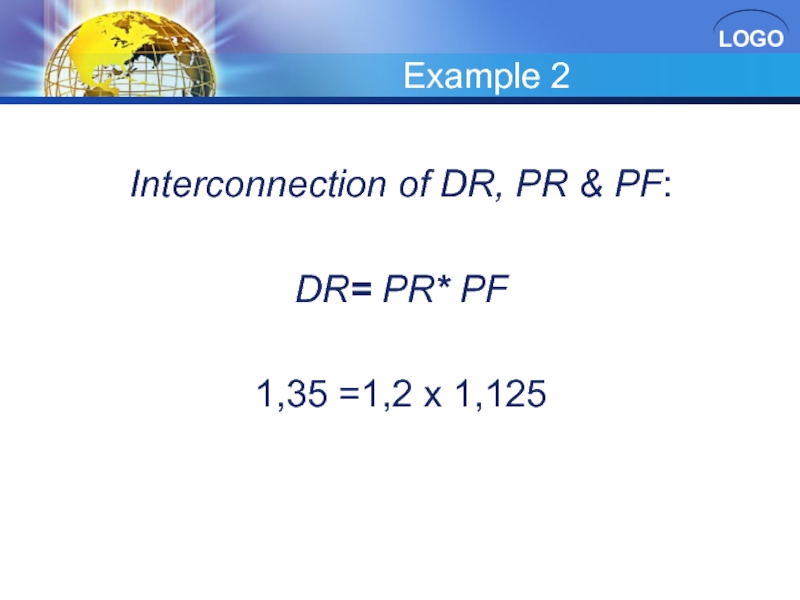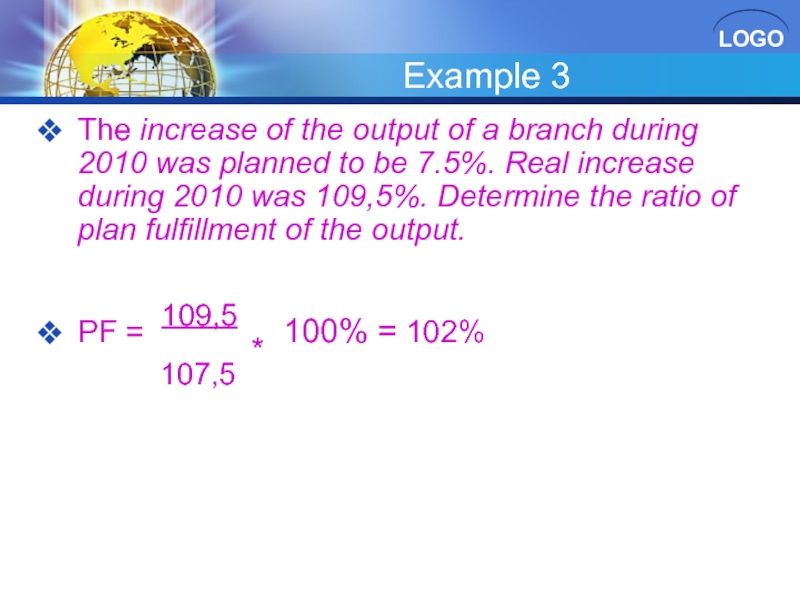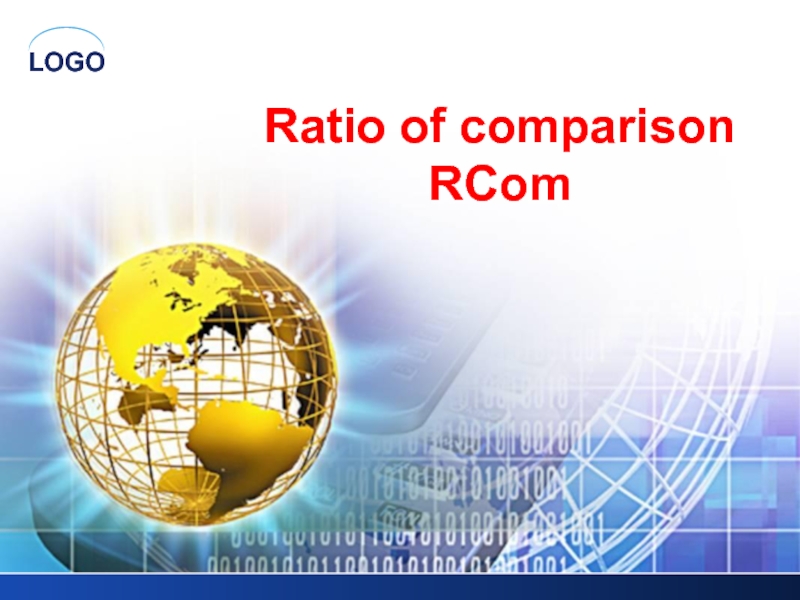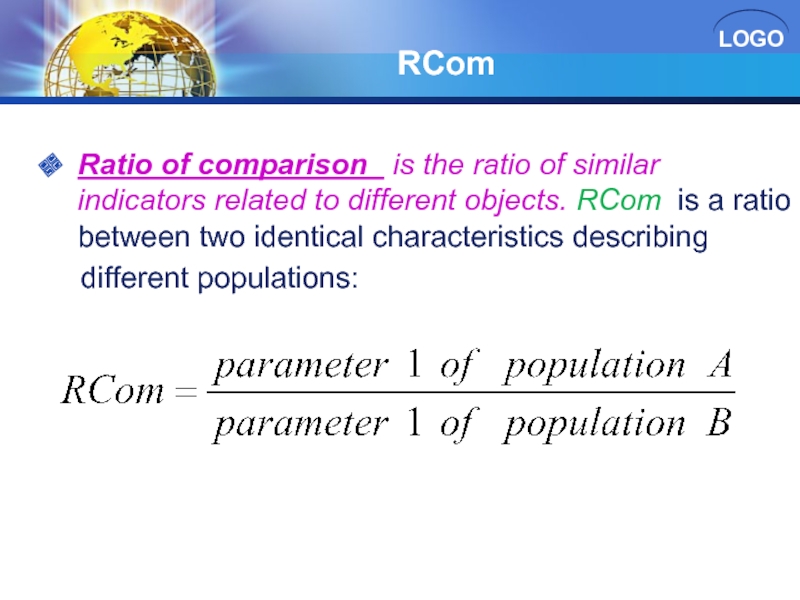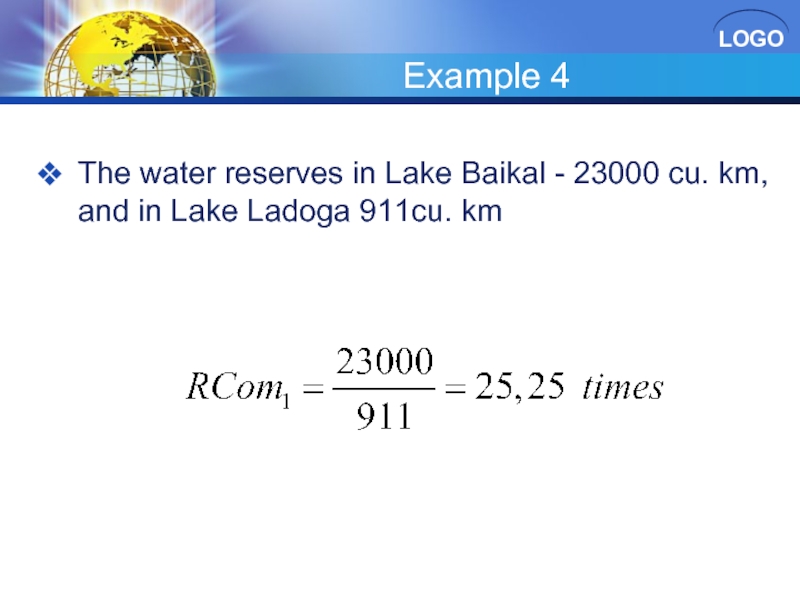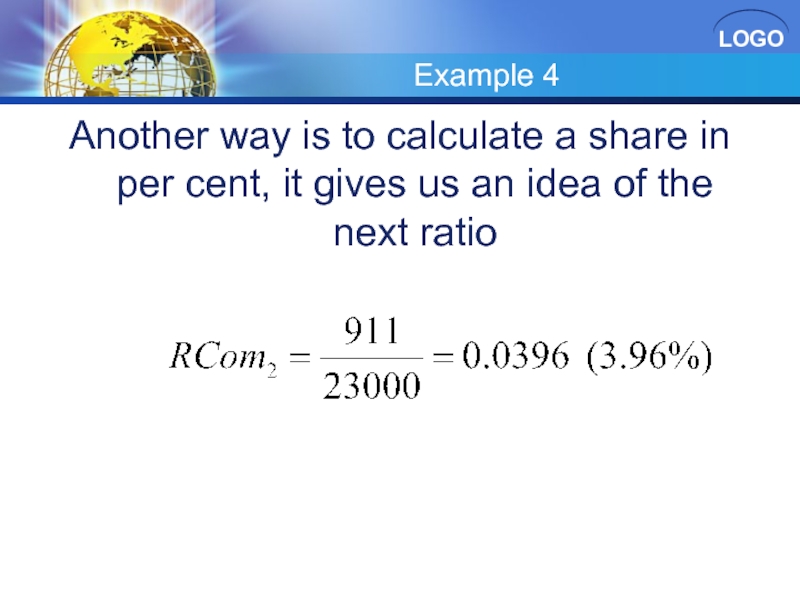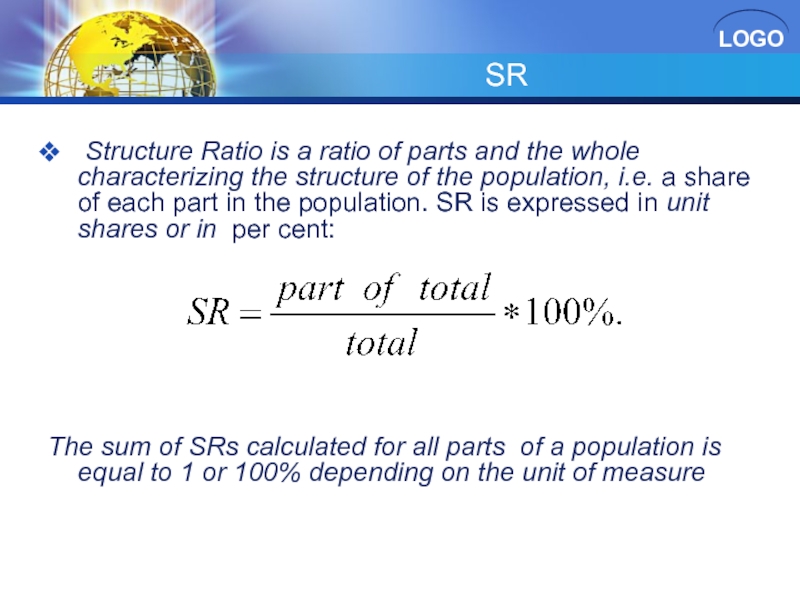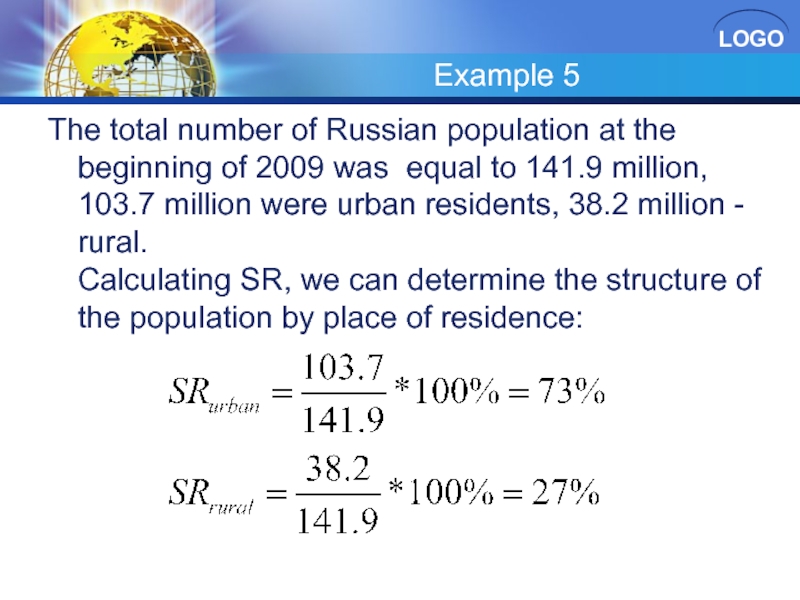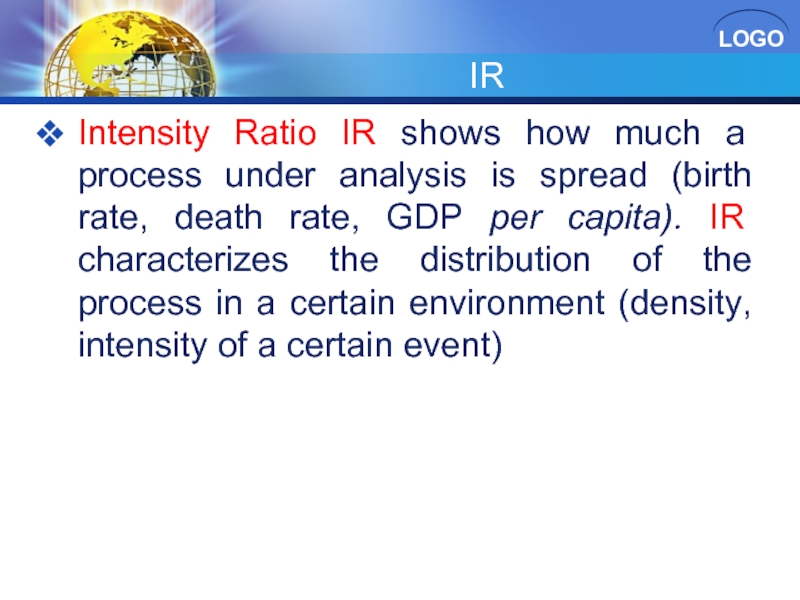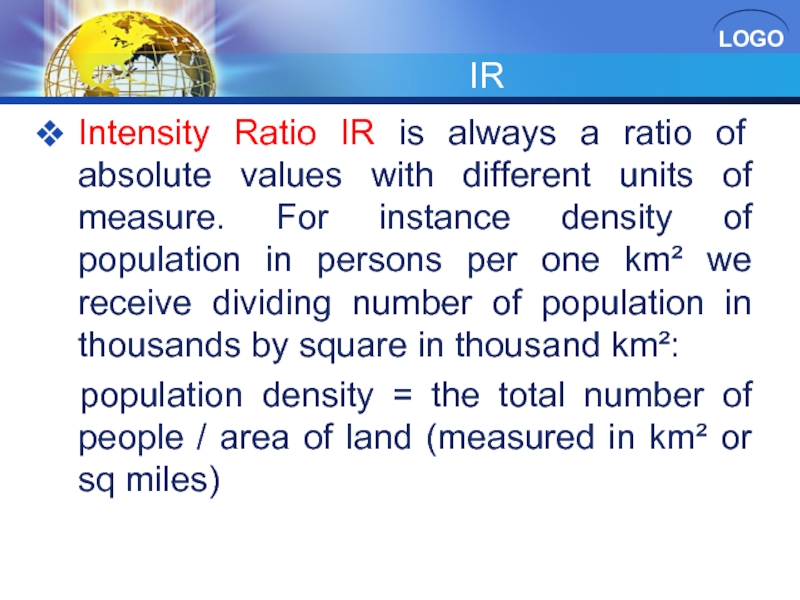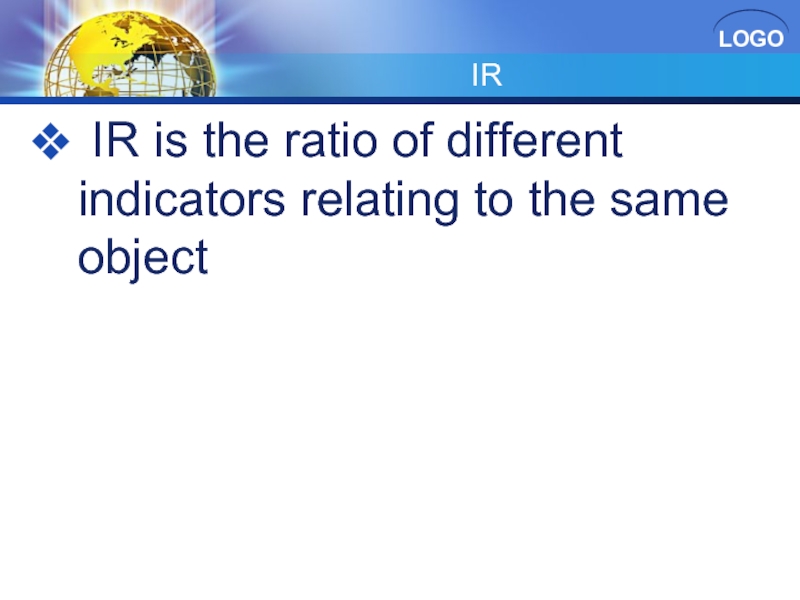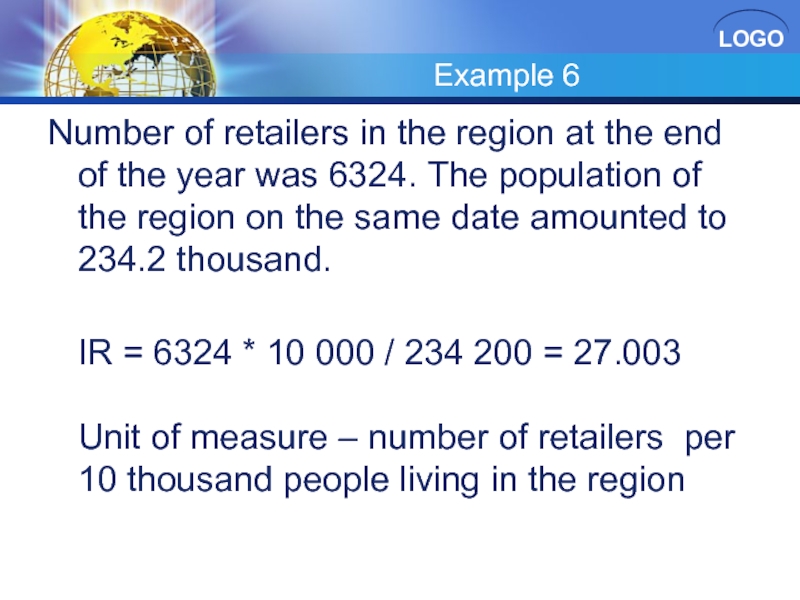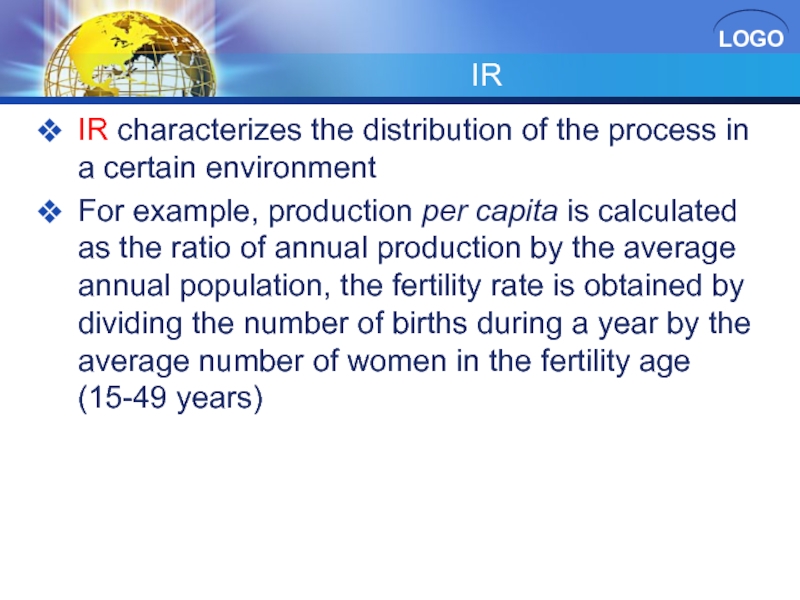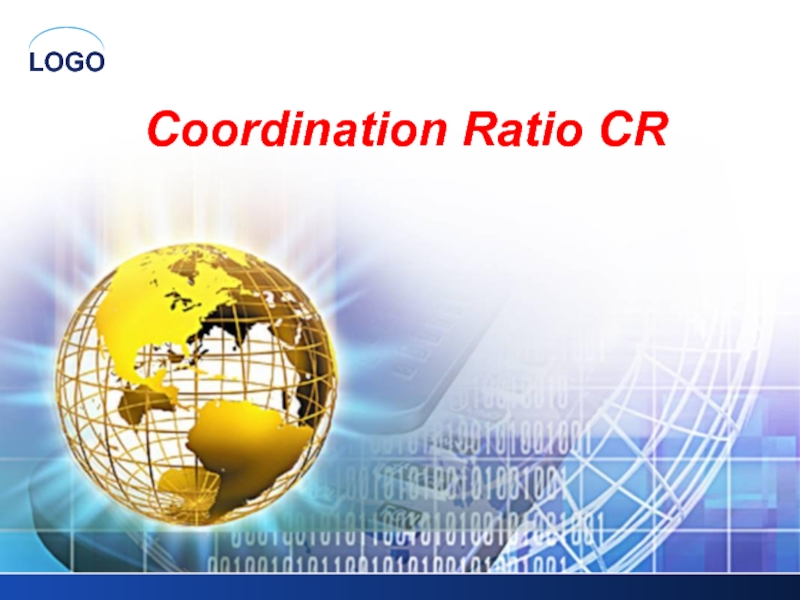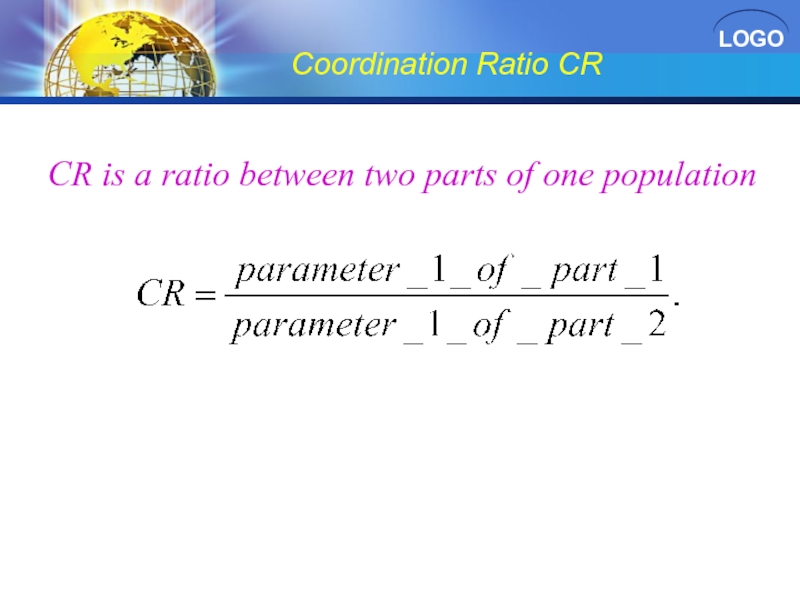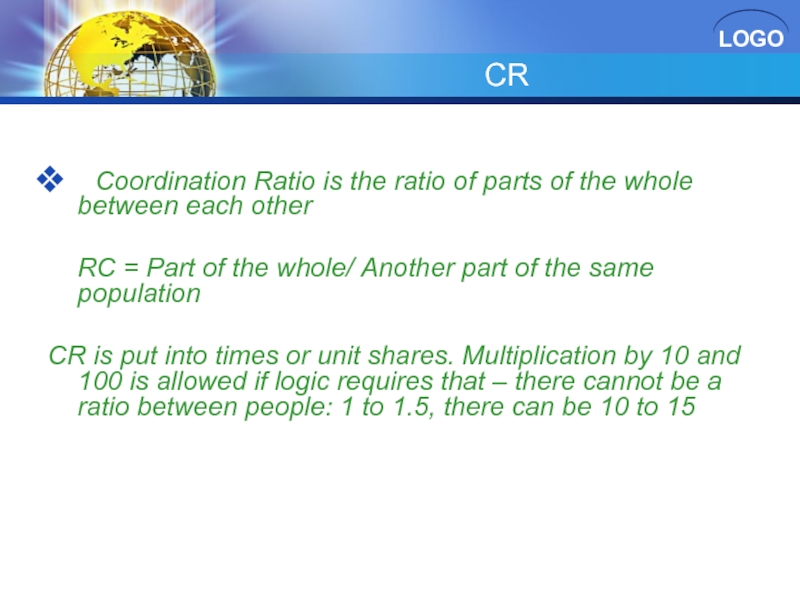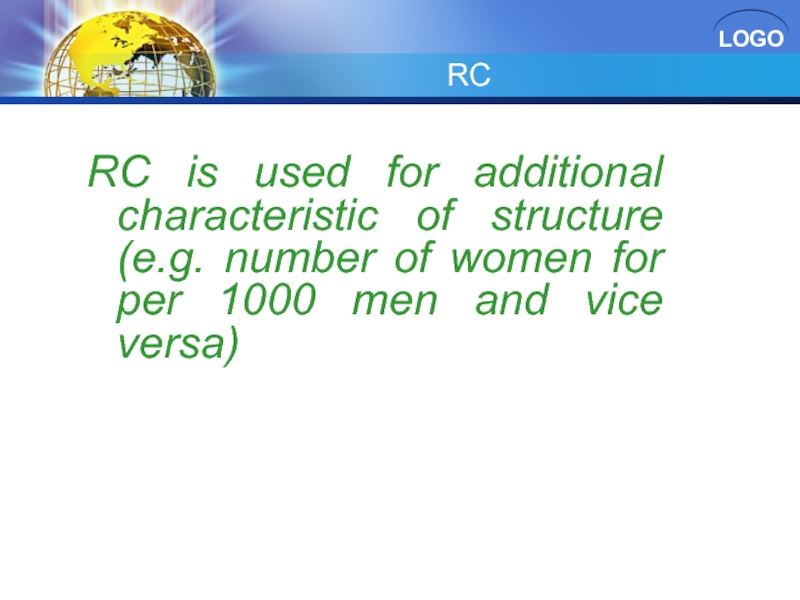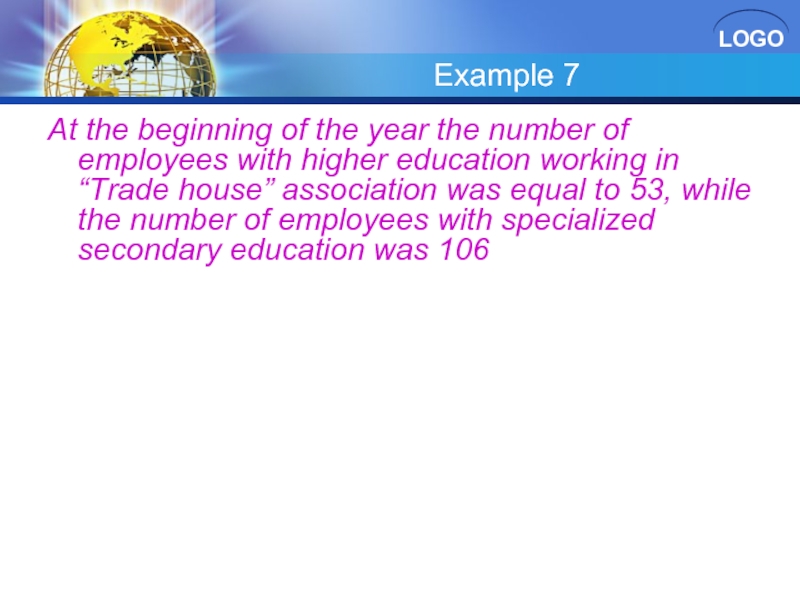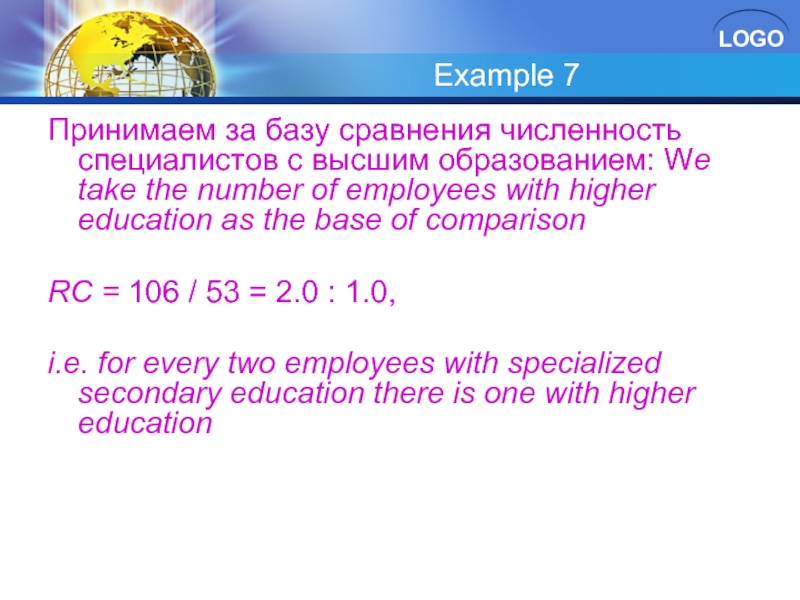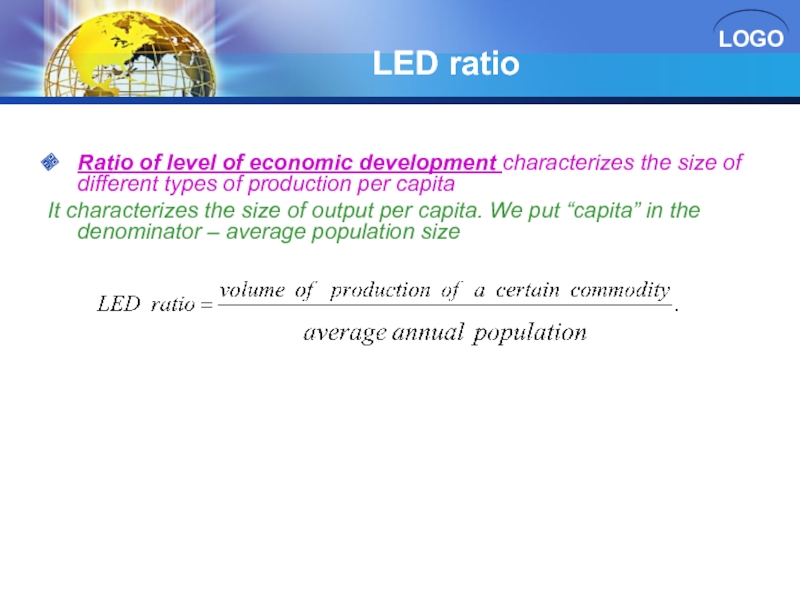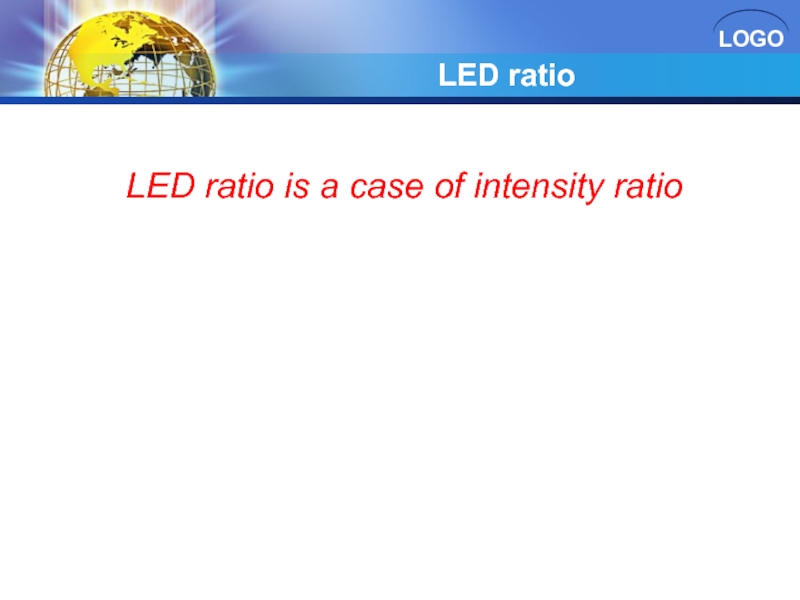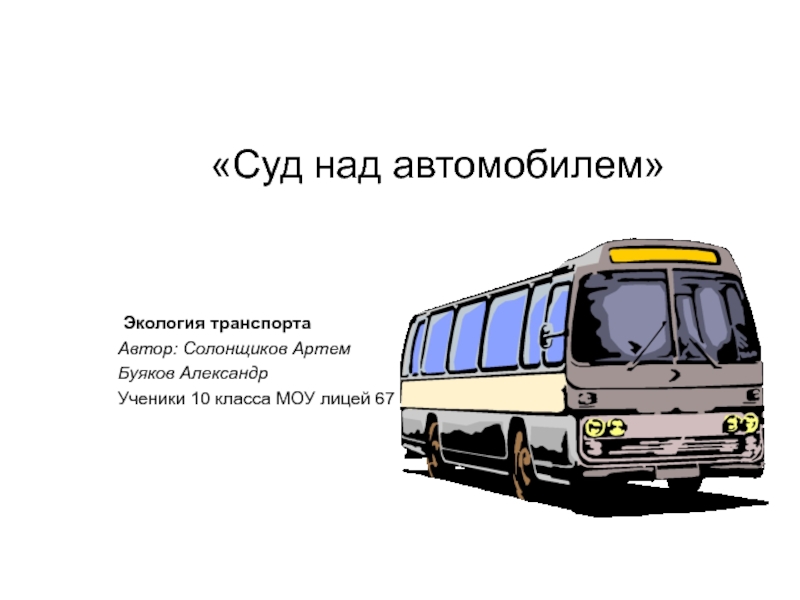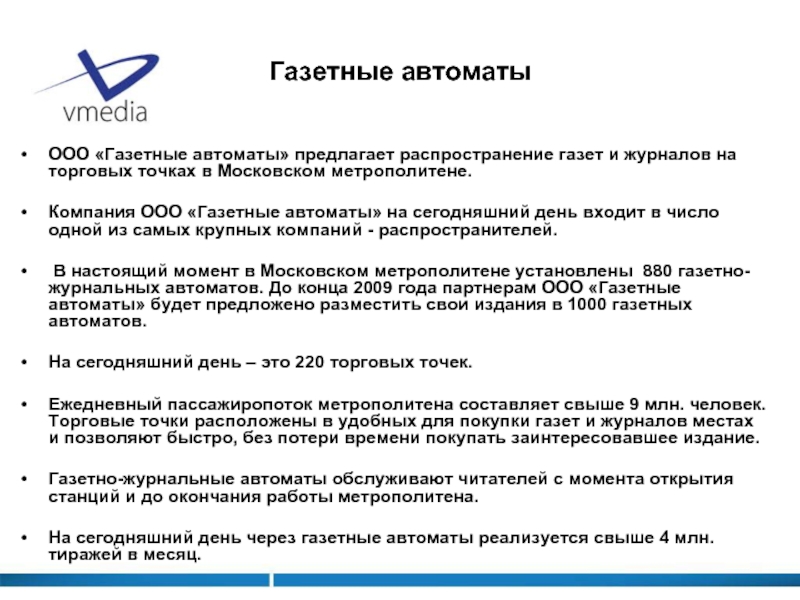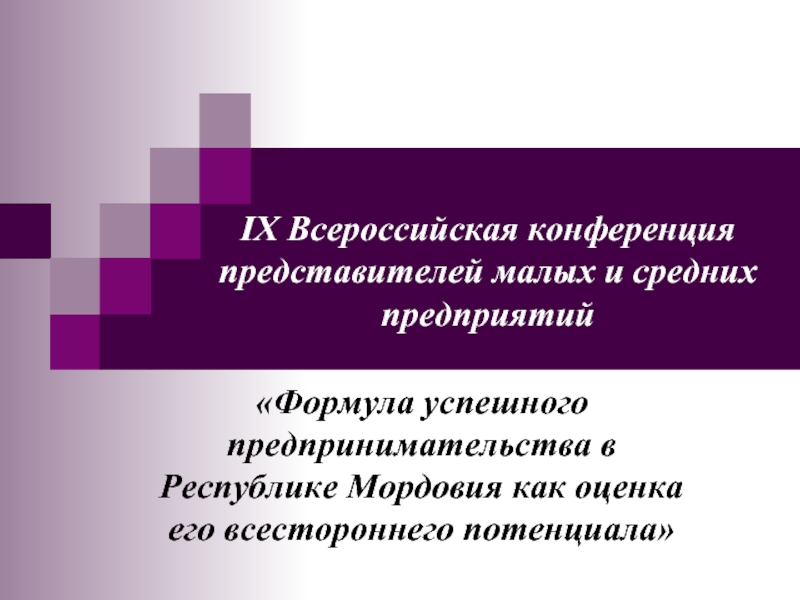- Главная
- Разное
- Дизайн
- Бизнес и предпринимательство
- Аналитика
- Образование
- Развлечения
- Красота и здоровье
- Финансы
- Государство
- Путешествия
- Спорт
- Недвижимость
- Армия
- Графика
- Культурология
- Еда и кулинария
- Лингвистика
- Английский язык
- Астрономия
- Алгебра
- Биология
- География
- Детские презентации
- Информатика
- История
- Литература
- Маркетинг
- Математика
- Медицина
- Менеджмент
- Музыка
- МХК
- Немецкий язык
- ОБЖ
- Обществознание
- Окружающий мир
- Педагогика
- Русский язык
- Технология
- Физика
- Философия
- Химия
- Шаблоны, картинки для презентаций
- Экология
- Экономика
- Юриспруденция
Ratios презентация
Содержание
- 1. Ratios
- 2. Statistical Indicators Statistical indicator
- 3. Individual & Summary Individual indicators characterize
- 4. Individual & Summary Summary Individual
- 5. Individual Individual absolute value characterizes one
- 6. Summary The summary, or total absolute
- 7. Individual & Summary When we study wages
- 8. Volumetric & Calculated Volumetric indicators
- 9. Absolute, Ratio & Average Absolute
- 10. Example 1 302. What is it?
- 11. 1.Absolute indicators In statistics, bare numbers can
- 12. Ratios
- 13. Ratio Any relative value is
- 14. Ratio RI=A/B
- 15. Ratios The ratio of quantities
- 16. Ratios The proportion expressing the
- 17. Ratios A ratio that has
- 18. Ratios Where the context makes
- 19. Ratios Ratios express numeric relation
- 20. Ratios In mathematics, a ratio
- 21. Quotient A quotient is the result of
- 22. Properties of Ratio Ratio shows how many times
- 23. Expression forms of ratios
- 24. Expression forms of ratios A comparison of
- 25. Simple Division RI=A/B This case of Ratio
- 26. Percentage RI=A*100/B To switch from % to
- 27. Per mil RI=A*1000/B Per mil: Latin pro
- 28. Examples of Ratio The quantities being compared
- 29. Display parameters The ratio
- 30. Per mil RI=A*1000/B To pass from per
- 31. There are seven kinds of ratios
- 32. Kinds of Ratios
- 33. Ratio of Plan target RP Plan Ratio
- 34. PR Plan Ratio is the ratio between
- 35. PF Ratios of plan fulfillment PF characterize
- 37. Basic DR Basic ratio of dynamics –
- 38. Chain DR Chain ratio of dynamics –
- 39. Chain method While using chain calculation method
- 40. Basic vs Chain
- 41. Basic vs Chain - 1 There is
- 42. Basic vs Chain - 2 2.Dividing the
- 43. Basic vs Chain - 3 3. Dividing
- 44. Example 3 The sale of cotton fabric
- 45. Example 1 Rates of growth Basic DRs
- 46. Correlation of 3 ratios DR = PR * PF
- 47. Example 2 In the third quarter the
- 48. Example 2
- 49. Example 2 Interconnection of DR, PR
- 50. Example 3 The increase of the output
- 51. Ratio of comparison RCom
- 52. RCom Ratio of comparison is
- 53. Example 4 The water reserves in
- 54. Example 4 Another way is to calculate
- 55. Structure Ratio SR
- 56. SR Structure Ratio is a
- 57. Example 5 The total number of Russian
- 58. Intensity Ratio IR
- 59. IR Intensity Ratio IR shows how much
- 60. IR Intensity Ratio IR is always a
- 61. IR IR is the ratio of different indicators relating to the same object
- 62. Example 6 Number of retailers in the
- 63. IR IR characterizes the distribution of the
- 64. Coordination Ratio CR
- 65. Coordination Ratio CR CR is a
- 66. CR Coordination Ratio is the
- 67. RC RC is used for additional
- 68. Example 7 At the beginning of the
- 69. Example 7 Принимаем за базу сравнения численность
- 70. Ratio of level of economic development LED
- 71. LED ratio Ratio of level of
- 72. LED ratio LED ratio is a case of intensity ratio
- 73. Your Task 3 1.Send a request for
- 74. Task 3 4. Bonuses: If you think
- 75. www.themegallery.com Thank You ! www.themegallery.com
Слайд 2Statistical Indicators
Statistical indicator is a numeric characteristic of social and economic
All indicators can be classified as individual and summary
Слайд 3 Individual & Summary
Individual indicators characterize only one unit of population
Summary
Слайд 5Individual
Individual absolute value characterizes one unit of the population investigated. It
Individual absolute values are obtained in the process of statistical observation and characterize the individual units of a population (a man's height, weight, volume of production, etc.)
Слайд 6Summary
The summary, or total absolute value characterizes the group of
Summary indicator gives us the characteristic size of the phenomenon analyzed on a given set of objects or any part of the set. The total values are obtained by direct counting of units of observation or as a result of summation of the values of quantitative traits, which have a unit (for example, the population of the country, a separate branch of production).
Слайд 7Individual & Summary
When we study wages the individual absolute indicator is
Summary indicators can also be classified as volumetric and calculated
Слайд 8 Volumetric & Calculated
Volumetric indicators are received by adding values
Calculated indicators can be received by making different calculations
All indicators can also be classified as absolute, ratio and average
Слайд 9 Absolute, Ratio & Average
Absolute indicators are measured in natural
Absolute values are the basis for the calculation of various statistical ratios
Average indicators will be described in the next lecture
Слайд 10Example 1 302. What is it? Possible answers: a) The date –
Слайд 111.Absolute indicators
In statistics, bare numbers can not exist without a specific
Слайд 13Ratio
Any relative value is the result of comparison of two
Ratio, or relative indicator RI represents the result of dividing one absolute indicator A by another B and expresses a ratio between two quantitative indicators
Слайд 15Ratios
The ratio of quantities A and B can be expressed
the ratio of A to B
as B is to A
A:B.
The quantities A and B are sometimes called terms with A being the antecedent and B being the consequent
Слайд 16Ratios
The proportion expressing the equality of the ratios A:B and
Again, A, B, C, D are called the terms of the proportion. A and D are called the extremes, and B and C are called the means. The equality of three or more proportions is called a continued proportion
Слайд 17Ratios
A ratio that has integers for both quantities and that
Sometimes it is useful to write a ratio in the form 1:n or n:1 to enable comparisons of different ratios.
For example, the ratio 4:5 can be written as 1:1.25 (dividing both sides by 4)
Alternatively, 4 : 5 can be written as
0.8: 1 (dividing both sides by 5)
Слайд 18Ratios
Where the context makes the meaning clear, a ratio in
Слайд 19Ratios
Ratios express numeric relation specific to particular social phenomena or
The indicator A is called compared value. The indicator B, that is compared with indicator A, is called the base or a base of comparison.
When both indicators namely A and B have the same unit of measure, the result is expressed in coefficient (e.g. 0.3), percentage (30%) or per mil (from Latin pro mille) (300 ‰)
Слайд 20Ratios
In mathematics, a ratio expresses the magnitude of quantities relative
Слайд 21Quotient
A quotient is the result of a division. For example, when dividing
A quotient can also mean just the integer part of the result of dividing two integers. For example, the quotient of 13 ÷ 5 would be 2 while the remainder would be 3
Слайд 22Properties of Ratio
Ratio shows how many times the compared value A is
Another important property - the ratio abstracts from absolute values and allows to compare indicators, the absolute amounts of which are not directly comparable
Слайд 24Expression forms of ratios
A comparison of the absolute values with the
A comparison of values with different names gives us named ratios. Their name is formed as combination of the names of A and B. The choice of form depends on the nature of analytical problems: just to express the ratio most clearly
Слайд 25Simple Division
RI=A/B
This case of Ratio shows:
1 - how many times
2 - what proportion of A is in relation to B
3 - in some cases, the Ratio indicates how many units of A corresponds per unit of B
Слайд 26Percentage
RI=A*100/B
To switch from % to coefficient, RI should be divided by
To obtain % from coefficients, we’ll multiply RI by 100
Слайд 27Per mil
RI=A*1000/B
Per mil: Latin pro mille, i.e. per one thousand. This
Слайд 28Examples of Ratio
The quantities being compared in a ratio might be
Слайд 29Display parameters
The ratio of width to height of typical computer displays
Older
Слайд 30Per mil
RI=A*1000/B
To pass from per mil to coefficients, RI should be
To obtain per mil from coefficients, multiply RI by 1000
To go from per mil to per cent, RI divide by 10
To move from per cent to per mil, multiply RI by 10
Слайд 32Kinds of Ratios
Kinds of RI
Plan Ratio
PR
Intensity Ratio IR
Ratio of Plan
PF
Dynamics Ratio
DR
Coordination Ratio
CR
Structure Ratio SR
Ratio of Comparison
RCom
Слайд 33Ratio of Plan target RP
Plan Ratio PR is a ratio between
where - plan indicator;
- real level of basic period
Слайд 34PR
Plan Ratio is the ratio between the value of indicator set
PR is expressed in coefficients or percentages after additional multiplication by 100%
In case of coefficients PR shows by how many times the plan is larger or smaller than achieved values by the planned period
In case of percentage PR shows by how many percent the planned value is larger or smaller than the actual value in previous or past value
Слайд 35PF
Ratios of plan fulfillment PF characterize the extent of accomplishment of
PF is the ratio between the current or reporting value and the planned value :
where - achieved indicator ;
- planned indicator.
It shows how the plan has been fulfilled
Слайд 36
Dynamics Ratio or Time Ratio DR – represents the ratio of values of the same indicator during different periods of time). It is a ratio between the current or reporting value x1 and the past or base meaning x0 and expressed in percentages
where x1 – real, achieved indicator ;
x0 – basic indicator.
There are two kinds of DR – chain and basic
Слайд 37Basic DR
Basic ratio of dynamics – ratio between the value of
where x1 – current level;
x0 – basic level
Слайд 38Chain DR
Chain ratio of dynamics – ratio between the current value
where xi – current level;
xi-1 – previous adjacent level
Слайд 39Chain method
While using chain calculation method we should compare each consequent
Time series analysis indicates its levels by letter Y instead of X
Слайд 41Basic vs Chain - 1
There is a connection between chain and
1.Multiplying each chain DR we’ll get basic DR of the last period:
Слайд 42Basic vs Chain - 2
2.Dividing the following basic DR by the
Слайд 43Basic vs Chain - 3
3. Dividing the following basic DR by
Слайд 44Example 3
The sale of cotton fabric by a section of department
Слайд 45Example 1
Rates of growth
Basic DRs (basis – level of sales in
DRF/J = 4200 * 100% =106,3%
3950
DRMJ = 4700 * 100% =118,9%
3950
Chain RDs
DRF/J = 4200 * 100% =106,3%
3950
DRM/F = 4700 * 100% =111,9%
4200
Слайд 47Example 2
In the third quarter the turnover was 150 million rubles.
y0=150;
y1pl=180;
y1=202,5
Слайд 50Example 3
The increase of the output of a branch during 2010
PF = 109,5 * 100% = 102%
107,5
Слайд 52RCom
Ratio of comparison is the ratio of similar indicators related
different populations:
Слайд 54Example 4
Another way is to calculate a share in per cent,
Слайд 56 SR
Structure Ratio is a ratio of parts and the whole
The sum of SRs calculated for all parts of a population is equal to 1 or 100% depending on the unit of measure
Слайд 57 Example 5
The total number of Russian population at the beginning of
Слайд 59IR
Intensity Ratio IR shows how much a process under analysis is
Слайд 60IR
Intensity Ratio IR is always a ratio of absolute values with
population density = the total number of people / area of land (measured in km² or sq miles)
Слайд 62 Example 6
Number of retailers in the region at the end of
IR = 6324 * 10 000 / 234 200 = 27.003 Unit of measure – number of retailers per 10 thousand people living in the region
Слайд 63IR
IR characterizes the distribution of the process in a certain environment
For
Слайд 66 CR
Coordination Ratio is the ratio of parts of the whole
RC = Part of the whole/ Another part of the same population
CR is put into times or unit shares. Multiplication by 10 and 100 is allowed if logic requires that – there cannot be a ratio between people: 1 to 1.5, there can be 10 to 15
Слайд 67RC
RC is used for additional characteristic of structure (e.g. number of
Слайд 68 Example 7
At the beginning of the year the number of employees
Слайд 69 Example 7
Принимаем за базу сравнения численность специалистов с высшим образованием: We
RC = 106 / 53 = 2.0 : 1.0,
i.e. for every two employees with specialized secondary education there is one with higher education
Слайд 71LED ratio
Ratio of level of economic development characterizes the size of
It characterizes the size of output per capita. We put “capita” in the denominator – average population size
Слайд 73Your Task 3
1.Send a request for a Ratio Puzzle on email
2.Solve the puzzle: explain all calculations below the table
3.The number of points is equal to the number of cells filled (number of steps described below the table)
Слайд 74Task 3
4. Bonuses:
If you think the puzzle has no solution you
You may invent a new ratio puzzle and get a prize of minimum 50 points
5.Calculate the total desired number of your points gained
6.Send solved puzzle to my email
